Ultimate Umbria in 4 Weeks
#45
Join Date: Dec 2005
Posts: 1,319
Likes: 0
Received 0 Likes
on
0 Posts
Whitehall, thanks for this excellent trip report and photos. I’m very much enjoying revisiting Umbria with you! In 2004 our family together with two college friends stayed in a house near Todi, daytripped to Perugia, Assisi/Spello/Montefalco, and Orvieto, and visited nearby Montecastello di Vibio. We usually set out on the not overly busy highways and returned on the meandering more scenic smaller roads. In Spello, lovely memories of the rose stonework, the profusion of flower baskets, and the jewel tones of the Pinturicchio frescoes in the Baglioni Chapel. And then the ceramic basket with the twisted handle that I decided would be too difficult to transport (my husband always said you only regret the things you don’t buy).
#46
Original Poster
Join Date: Sep 2007
Posts: 1,758
Likes: 0
Received 0 Likes
on
0 Posts
Whitehall, thanks for this excellent trip report and photos. I’m very much enjoying revisiting Umbria with you! In 2004 our family together with two college friends stayed in a house near Todi, daytripped to Perugia, Assisi/Spello/Montefalco, and Orvieto, and visited nearby Montecastello di Vibio. We usually set out on the not overly busy highways and returned on the meandering more scenic smaller roads. In Spello, lovely memories of the rose stonework, the profusion of flower baskets, and the jewel tones of the Pinturicchio frescoes in the Baglioni Chapel. And then the ceramic basket with the twisted handle that I decided would be too difficult to transport (my husband always said you only regret the things you don’t buy).
#47
Join Date: Dec 2005
Posts: 1,319
Likes: 0
Received 0 Likes
on
0 Posts
Ah, the vagaries of online booking and all things in the years of the plague. We did tour Montecastello di V’s jewel box of a theater. I have memories, too, of meticulous stonework and imposing family crypts. An Italian colleague of my husband’s had recommended that we stay in Umbria and had singled out Spello for special mention as I recall. I was drawn to Pinturicchio at an exhibit that we had seen earlier in the week in Perugia.
#48
Original Poster
Join Date: Sep 2007
Posts: 1,758
Likes: 0
Received 0 Likes
on
0 Posts
Day 9: Castiglione del Lago, Isola Maggiore, Passignano sul Trasimeno
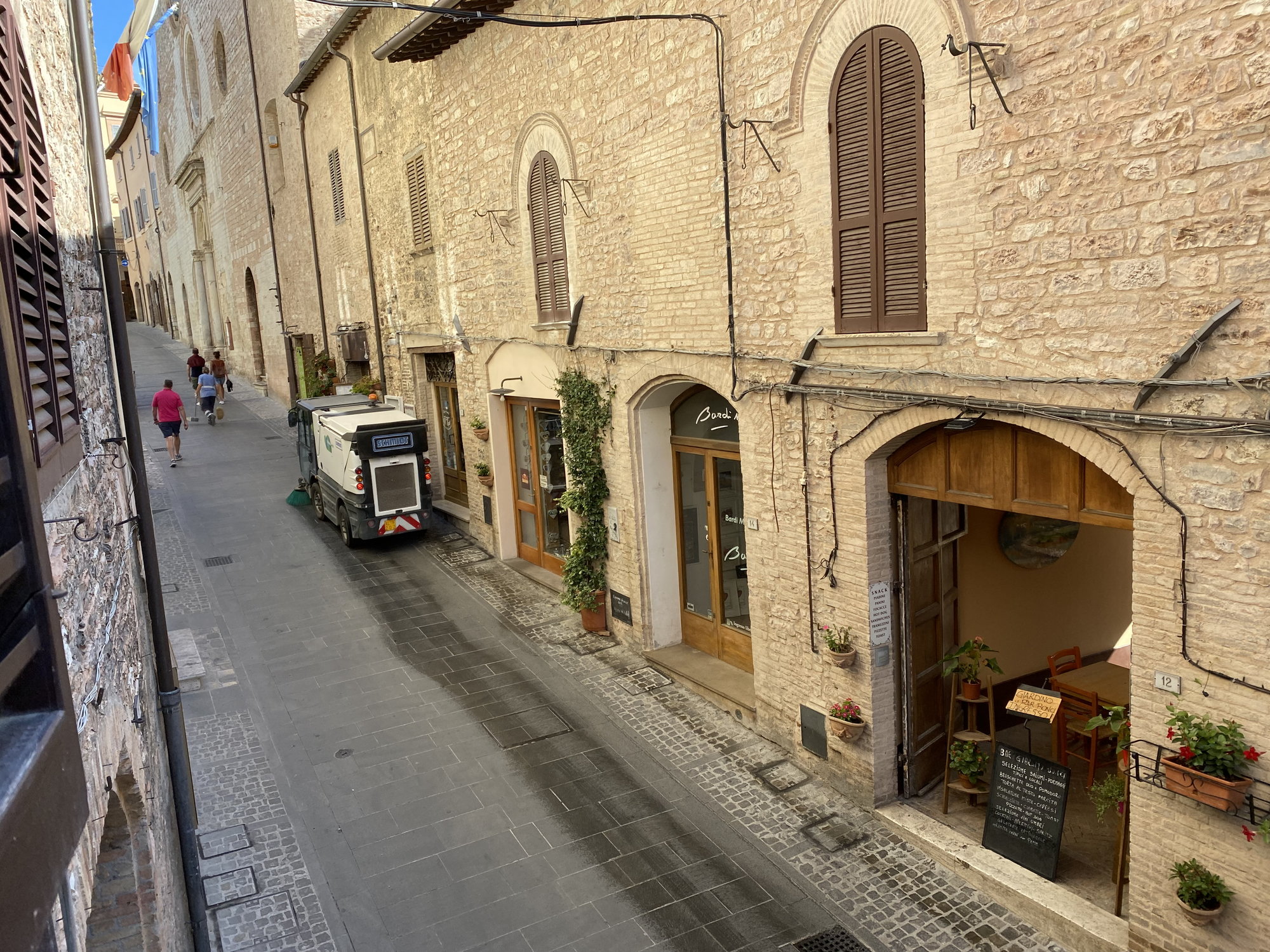
Spello
We were up early enough to watch the street cleaner help make Spello spic and span for the next onslaught of day trippers. We also needed to get ready for our first longer drive (still under one hour), this one to the edge of Tuscany; actually we drove through a small sliver of Tuscany to get to Lake Trasimeno.
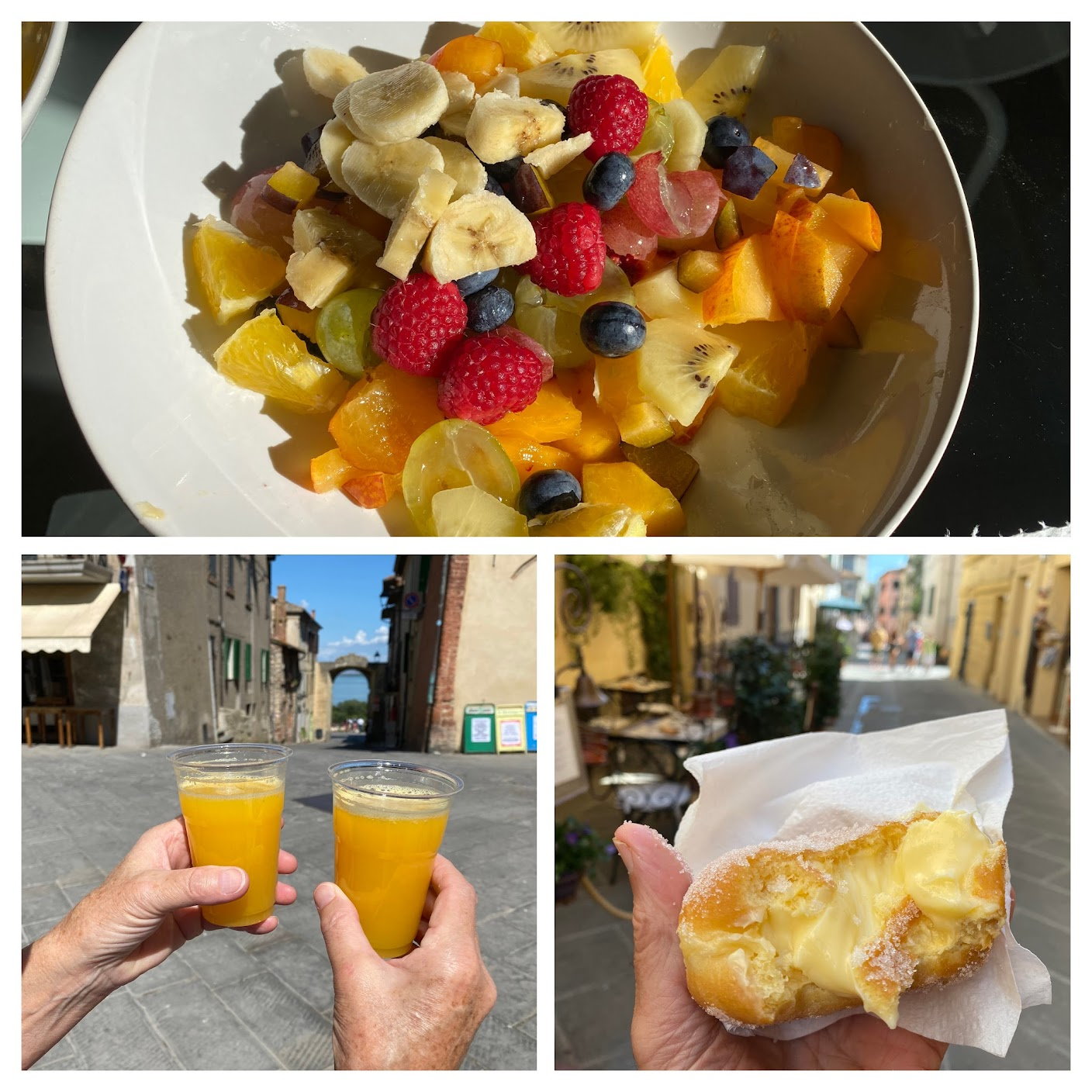
We started healthy, with fruit from our recent market visit, and then added fresh squeezed orange juice at a bar in Castiglione del Lago. All leading up to an excuse to go to Il Forno Pasticceria, perhaps the worst presentation of any bakery we have visited in Italy, where displays seem to be everything. But, the sweets looked fresh. The two donuts we selected were so heavy, we laughed when the nice lady handed us our bag. They were so full of pastry cream that they felt like each one weighed three pounds.

Castiglione del Lago
Lake Trasimeno looks small on first glance, but it is Italy’s fourth largest lake and almost the size of Lake Como. Castiglione del Lago is the most beautiful of various communities on the lake, sitting on a promontory above it. The area is rich in history, but now largely protected as a natural park, despite the several towns bordering it. Castiglione at one time was a significant medieval fortress protecting the main road from Florence to Rome. Even earlier, Hannibal destroyed a Roman army at the lake 200 years before Christ.
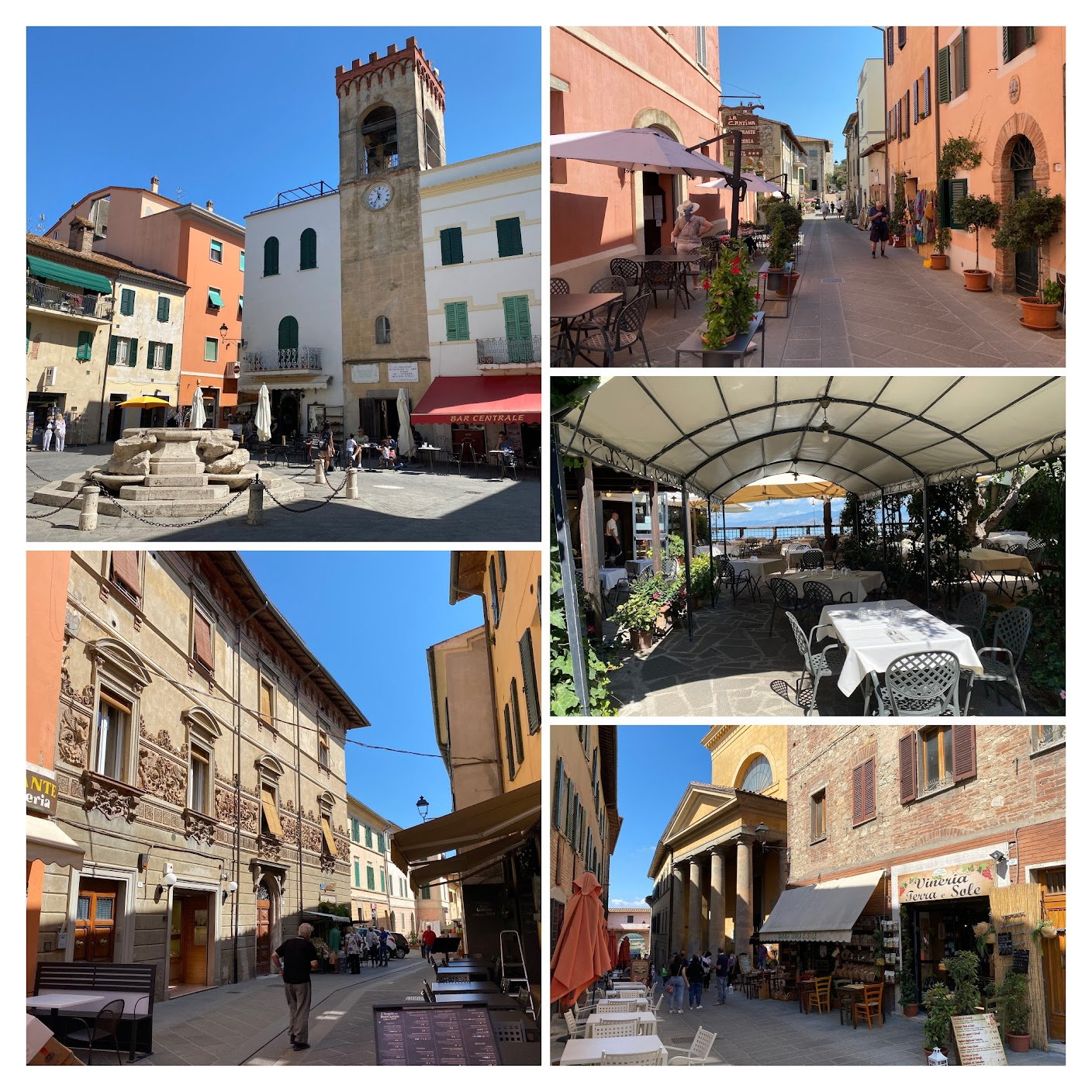
Castiglione is said to be busy in summer, but on this last day of August, the community was very quiet despite the presence of its many stores and restaurants.

Castiglione has a wide range of parkland along the lake, including a beach. Much of the land leading to the lake is covered with olive trees.
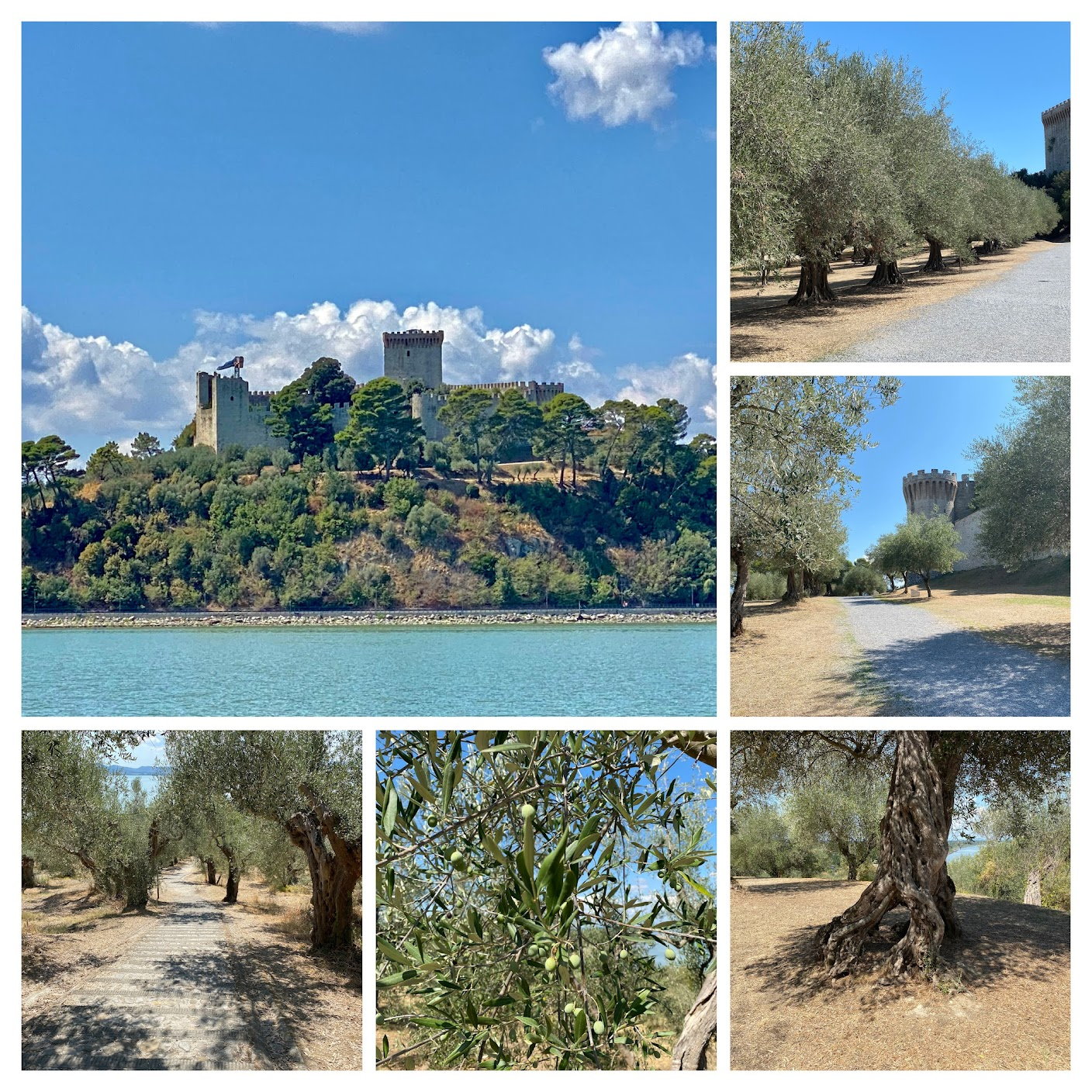
Landmarks in Castiglione include a fortress and a palace, which we skipped so that we could grab a ferry to an island in the lake. Castiglione in ancient times was considered a fourth island in the lake, when water levels were higher than today, but today it is on a peninsula. Two of the three islands in the lake are uninhabited and are nature preserves, although one of those does have a fortress and ruins of two churches and an abbey.
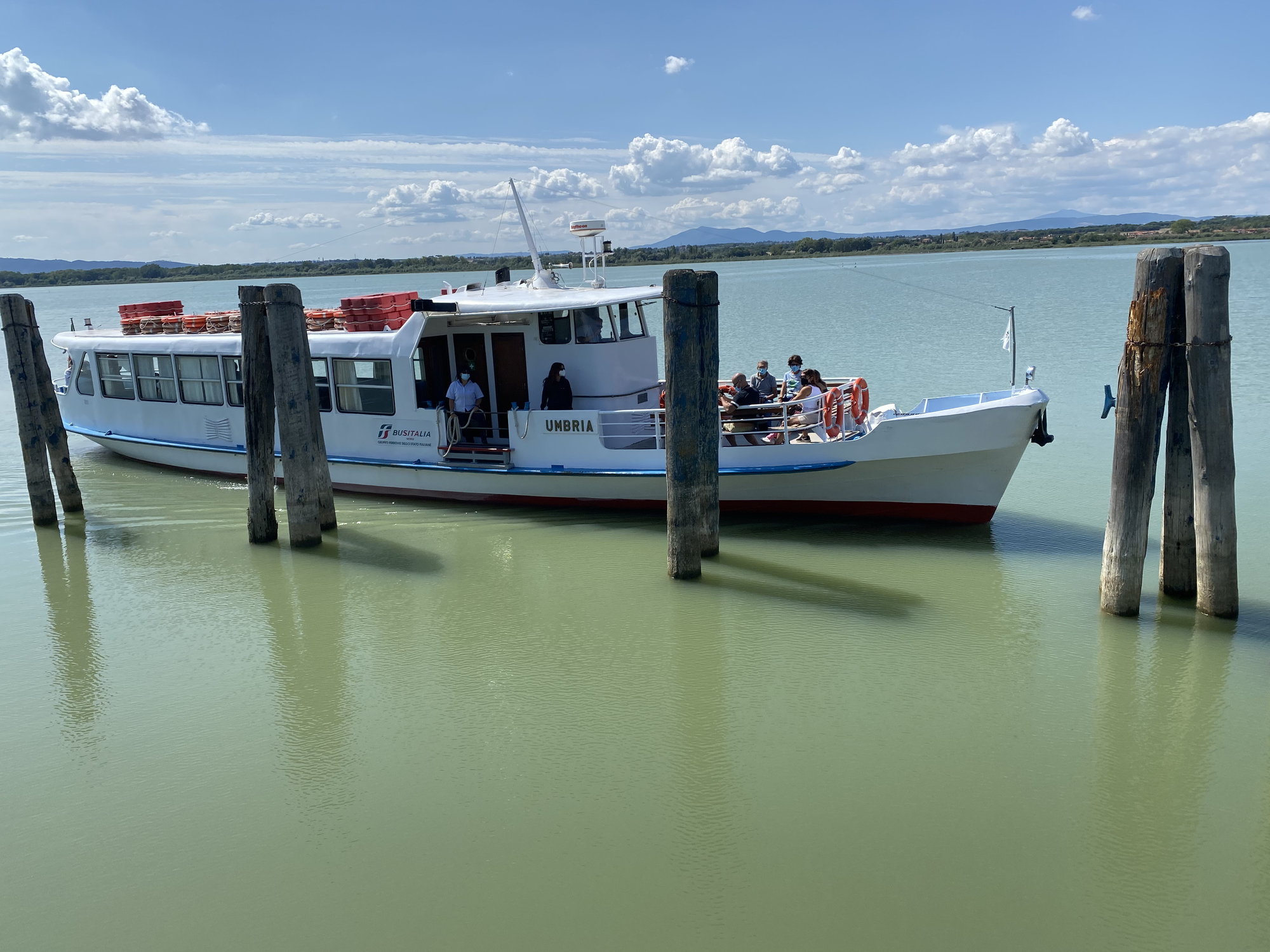
Busitalia, a company owned by the same group that owns the Italian rail companies Ferrovie and Trenitalia, operates a ferry from Castiglione to Isola Maggiore (Maggiore Island). We had not checked ferry schedules but lucked out as we were the last to board the small passenger boat and even landed a couple of outside seats in the front of the boat. Surprisingly not very busy, all Italians and a gorgeous summer day.
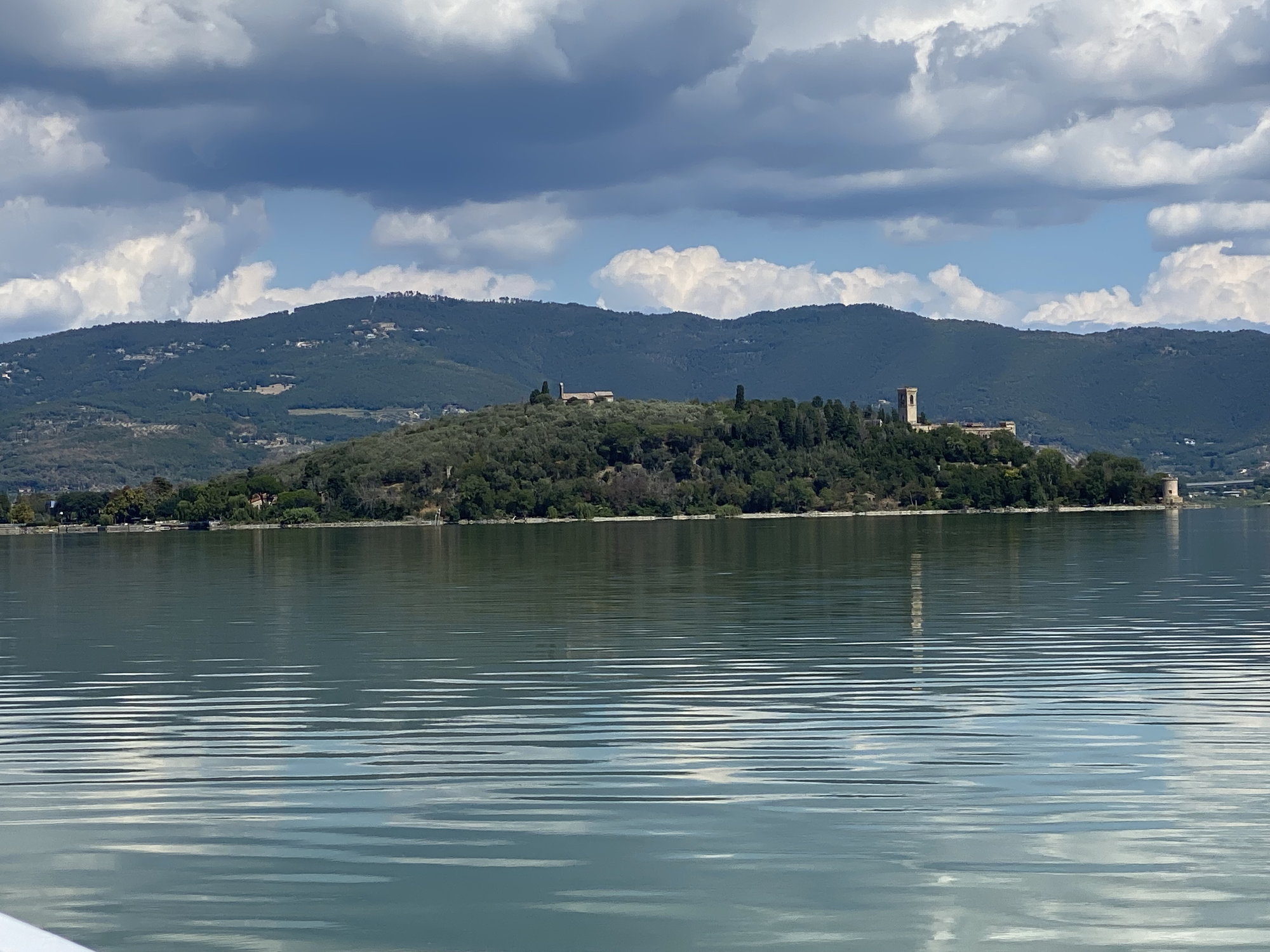
Isola Maggiore
The smooth ride to the island was quite pleasant, perhaps 15 or 20 minutes. As we approached the island, we saw a small village at water’s edge, a lone old church at the highest point on the island, and an obstructed view of what appeared to be a castle at one end of the island.
There was a little crush of people trying to leave the island on one of the two ferries leaving at the same time, one for Castiglione and the larger one to a closer town of Passignano sul Trasimeno. But this was the early lunch crowd, leaving the island almost deserted.

Isola Maggiore Village
Again a St. Francis of Assisi connection. Hard to believe he traveled so much, but in 1211, he became a hermit on the then empty island for 40 days during Lent. His Franciscan followers, maybe less than 100 years later, honored him by building the small church that stands tall today over the island. Shortly after, they built a nearby monastery.
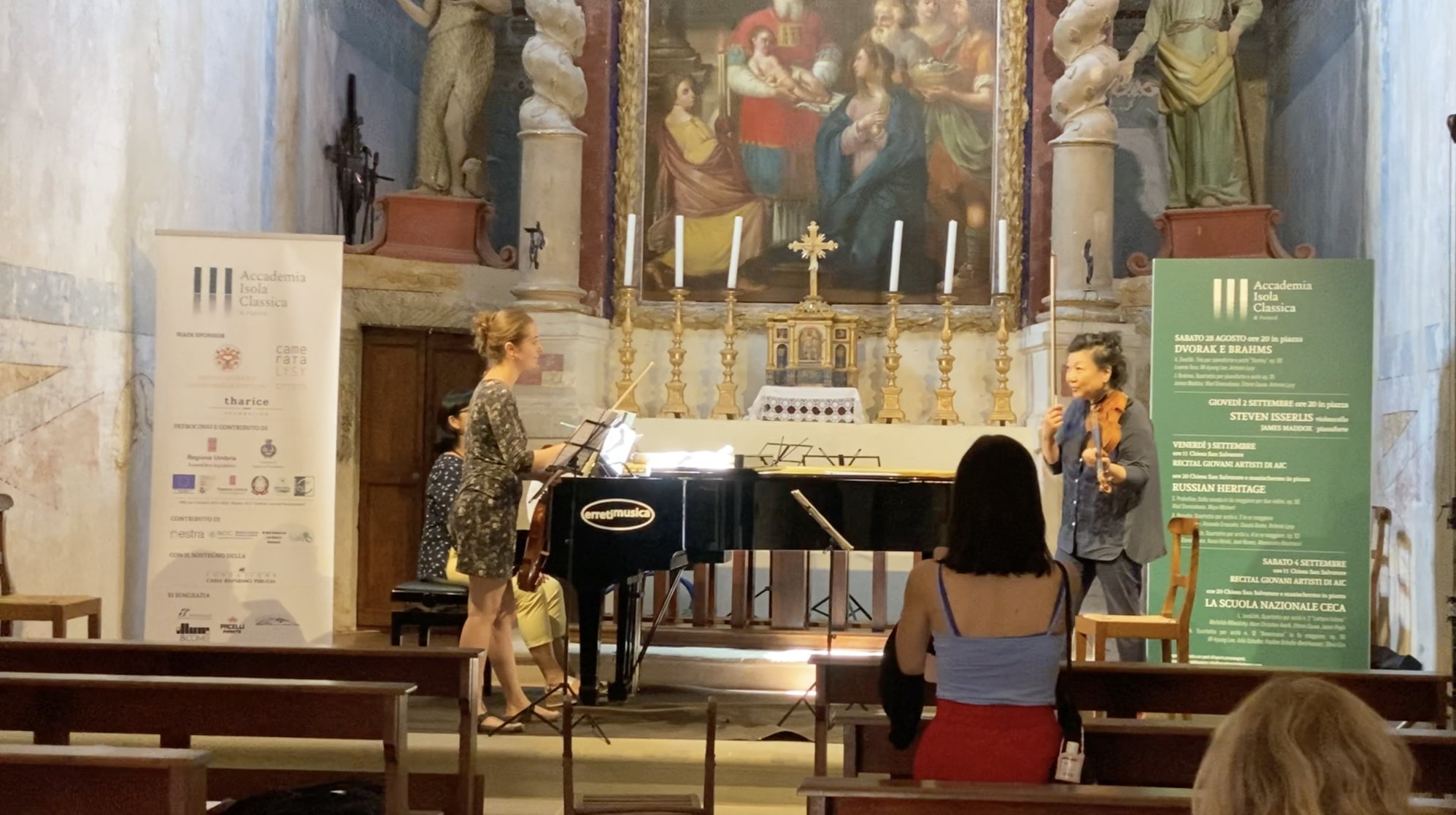
We heard the welcoming sounds of a violin when we entered the small main street. A masterclass of a dozen rising musicians (cello, viola and violin) from throughout the world were given guidance for several days by leading European musical professors, followed by chamber concerts the next two days. We came across two lessons, one in each of two small churches in this village of about three dozen residents. One of the teachers has been Grammy nominated; the teacher in this photo is a accomplished violinist Mi-Kyung Lee from Munich.
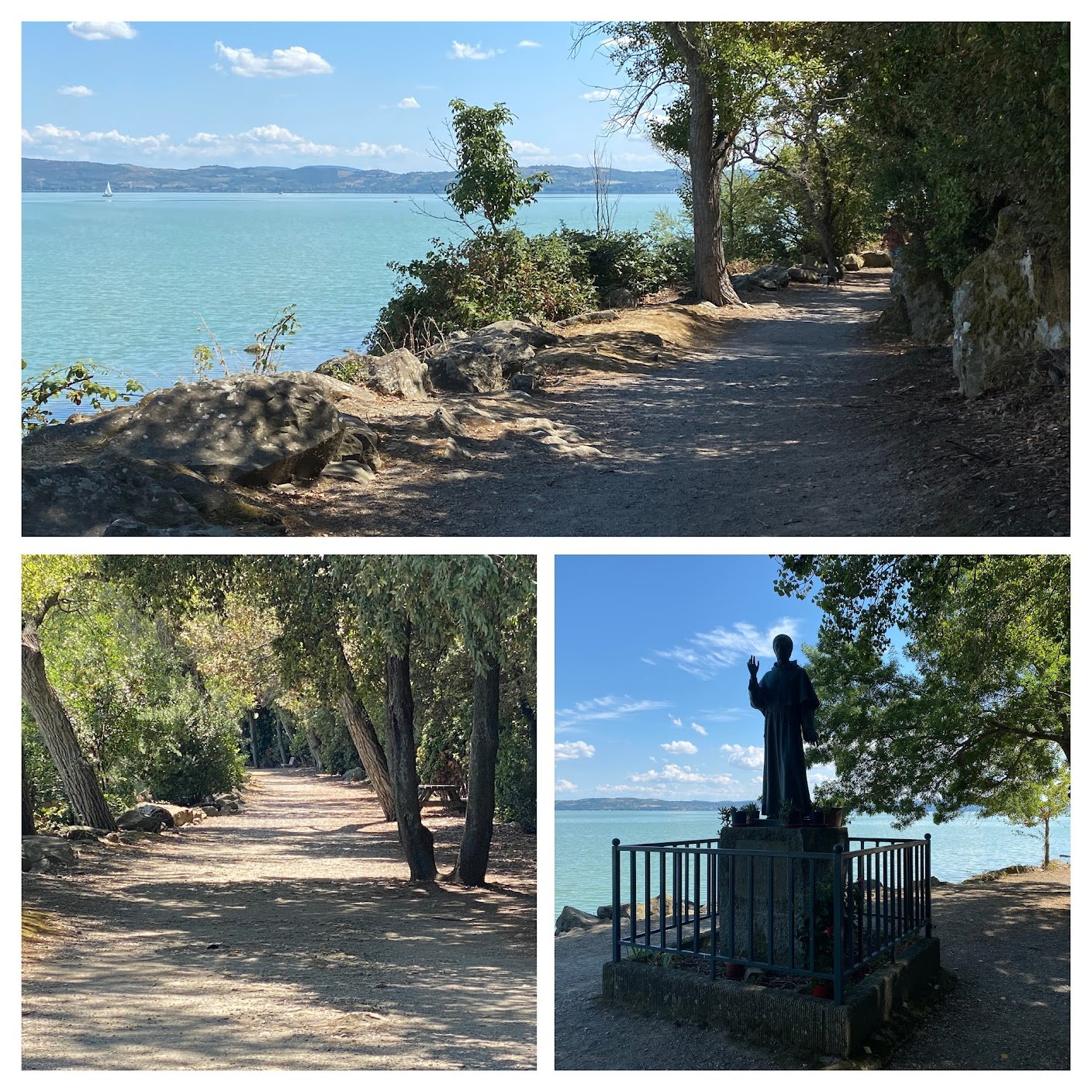
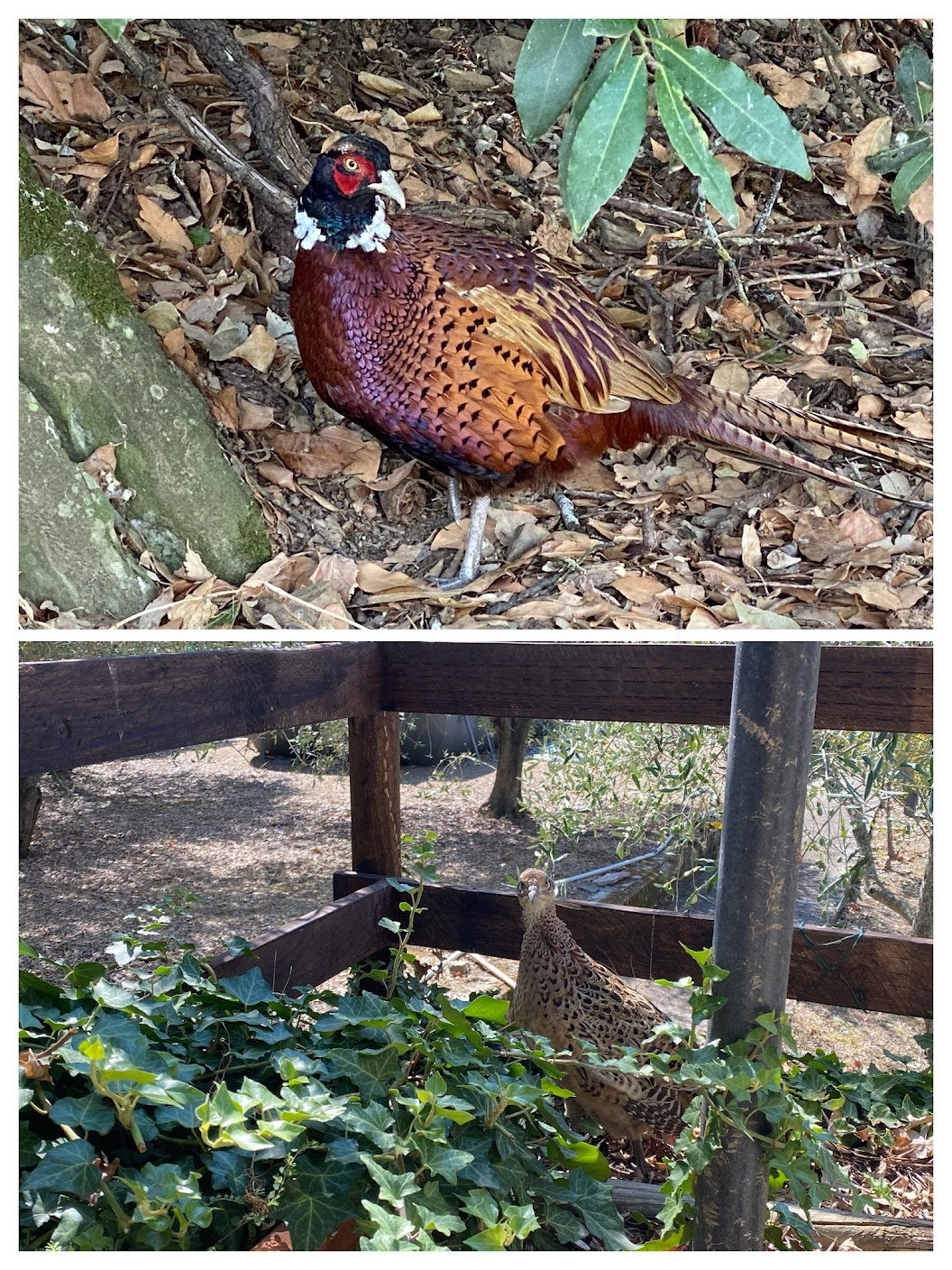
There is a nice, but relatively short path alongside the lake, maybe a 15 minute hike. Colorful pheasants and golden pheasants are plentiful and friendly, which suggests tourists feed them. Several of them followed us along the wide path.
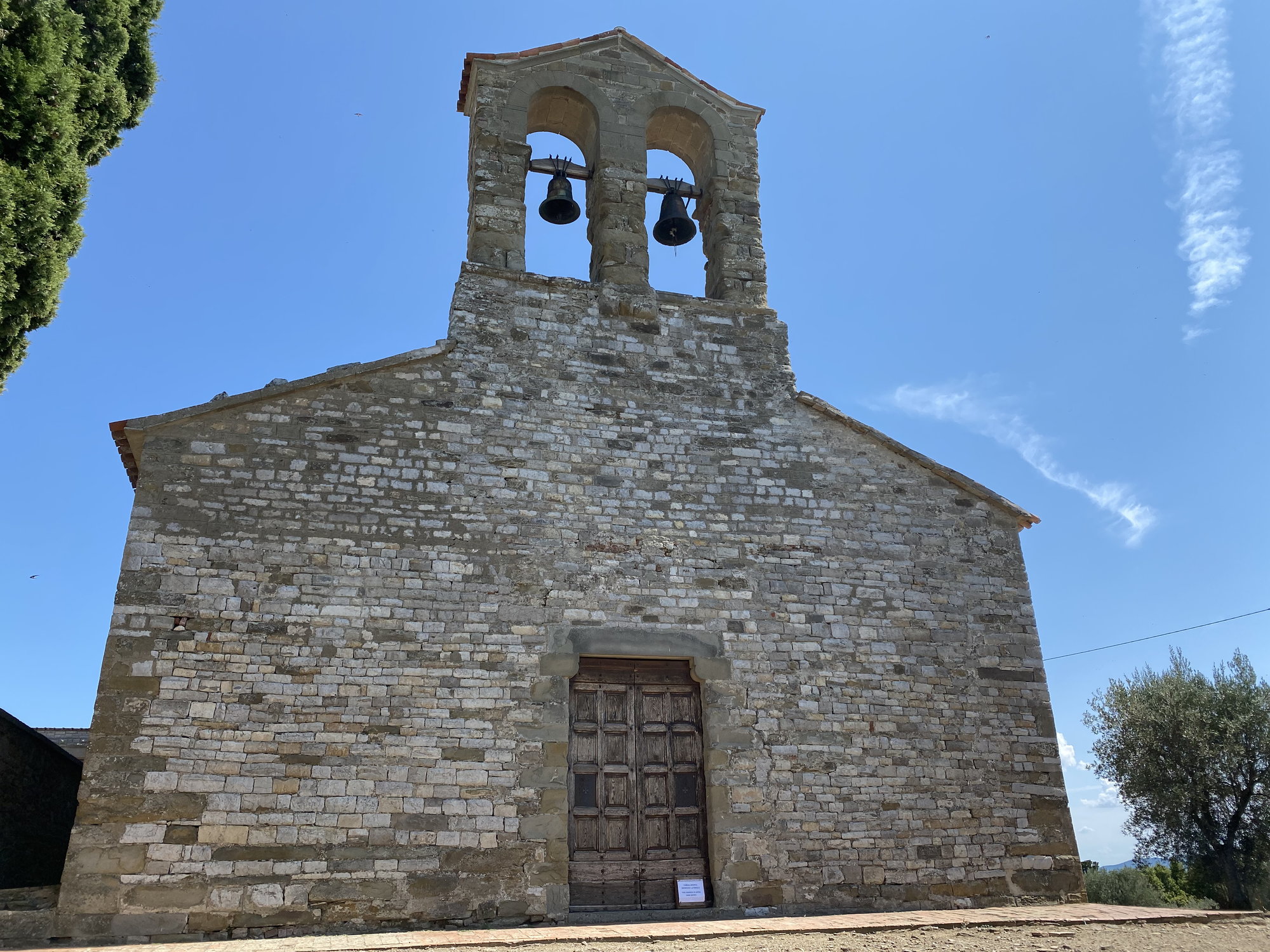
Eventually, the path ends at a large locked iron gate. To continue, a hiker must walk up to the ancient church at the top of the island which has an attached active cemetery. The simple church does open for limited tours during the peak of the day. And, then, a hiker can pick up another section of the path that leads back to the village.
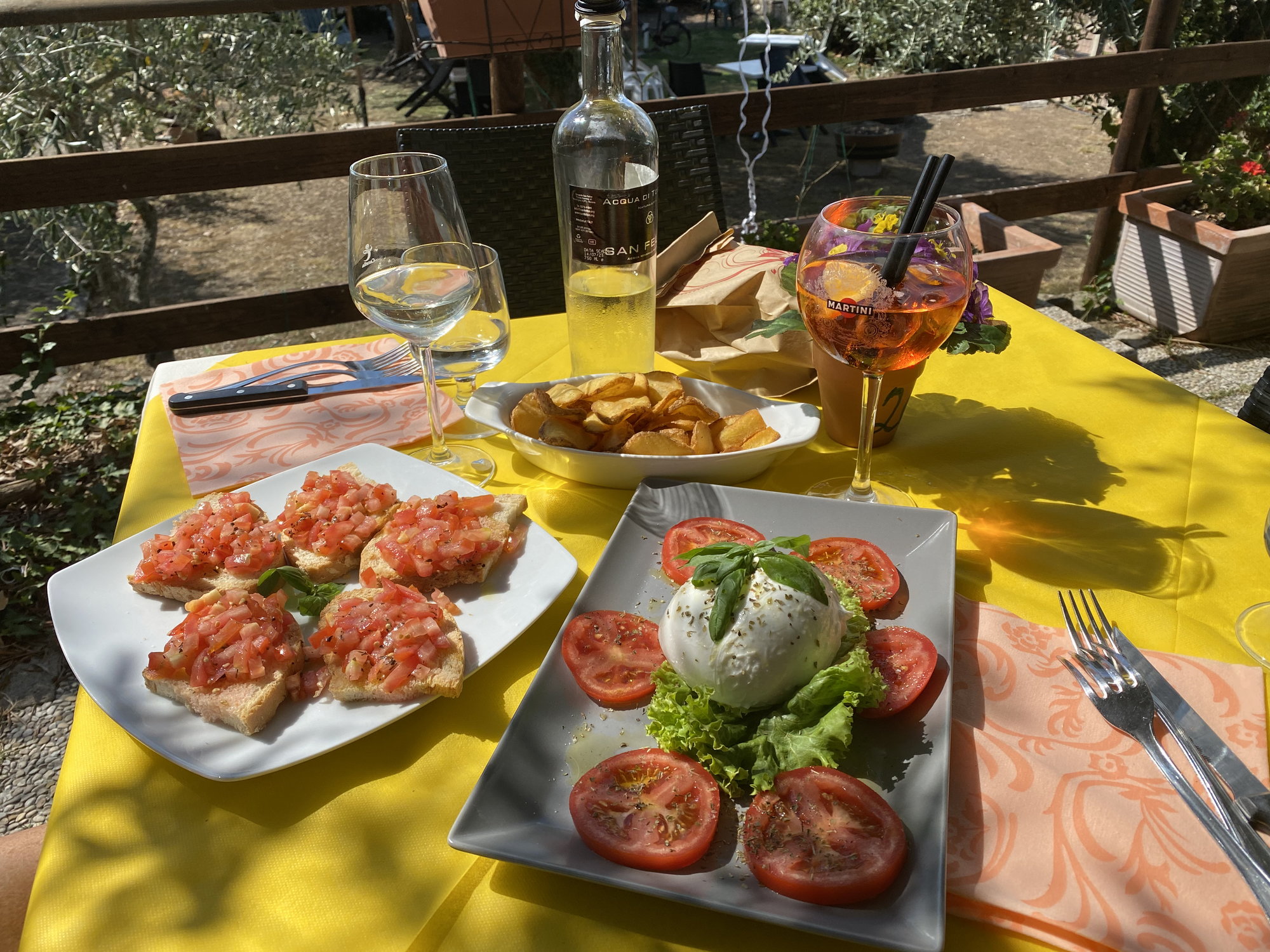
The walk back to town was easy and quick. We inquired with a local merchant about the castle and how someone might see it. The lady made it clear that it had been closed to the public for years and could not be viewed. That was disappointing. So, we decided to get lunch, since the dwindling number of tourists suggested that restaurants would soon close.
That heavy donut and a small gelato, when we arrived on the island, made us feel like having a light lunch. There was one lakeside place, where all the diners had emptied out and a friendly waiter beckoned us inside. We followed him to an empty outside terrace, with views of the lake through some trees.
We told him we just wanted something light, maybe just an appetizer. Perhaps I have a tomato fetish, but the bruschetta and their version of a caprese salad and a bowl of fried potatoes looked nice and were more than we could handle, but we did our best.
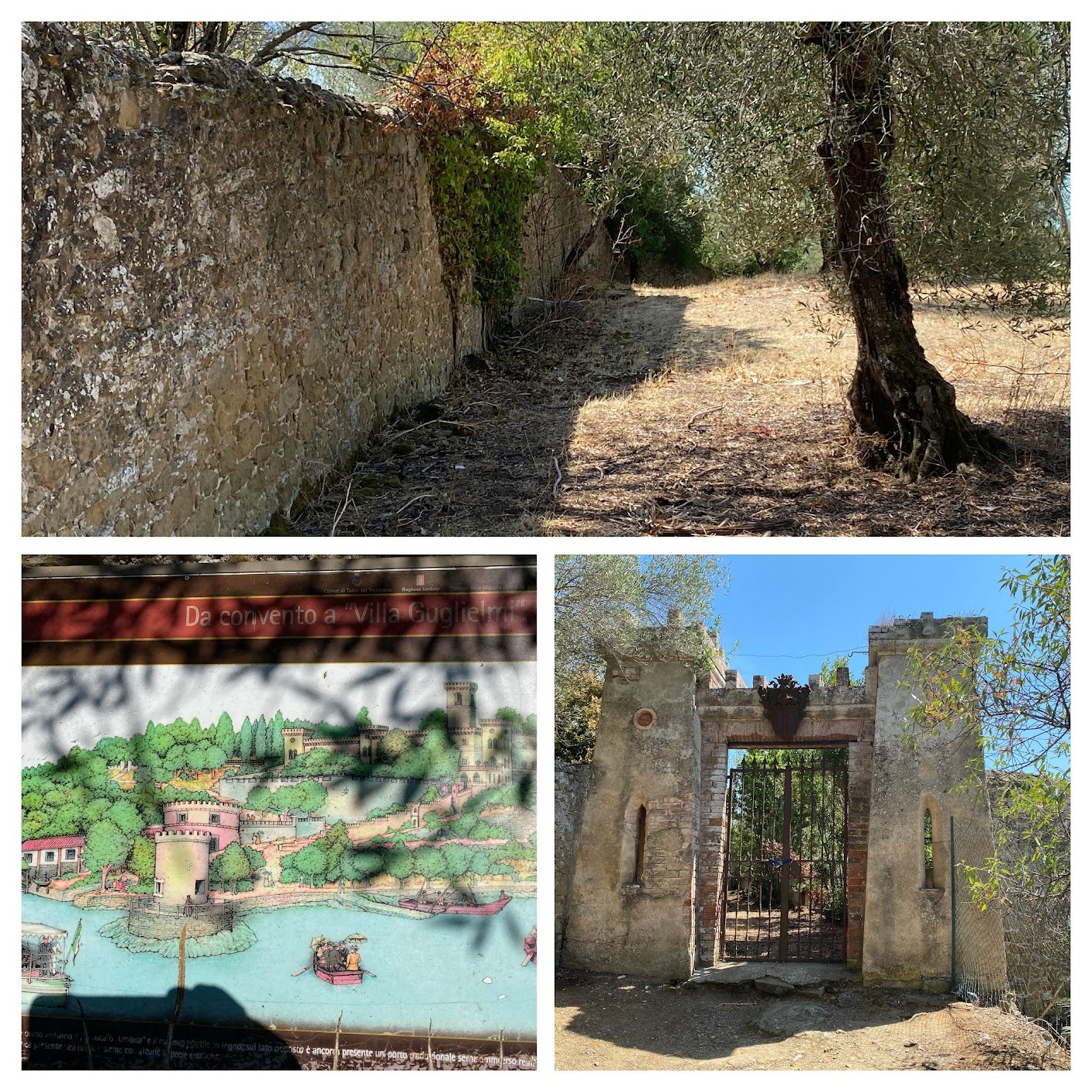
To walk it off, we headed back to the church and then found a second iron gate, with a nearby display showing a plan and photographs of the castle/summer mansion. For centuries, this was the home to the Franciscan monastery, until the property was purchased by a wealthy Italian politician named Guglielmi in the late 1800’s. He turned the monastery into a summer castle, with its own beautiful church and lots of other amenities, and gifted it to his wife. The drawings and photos suggest a one-of-a-kind lake side estate for the ultra-rich. The Guglielmi family in 1944 also used the castle to shelter some Italian Jews fleeing the Nazis. The family used the property until the 1970’s when it fell into disrepair, eventually picked up as a site for a future luxury hotel. By 2010, the latest dreamers left behind the scaffolding used in their exterior efforts and went bankrupt. And, the castle deteriorated even more.
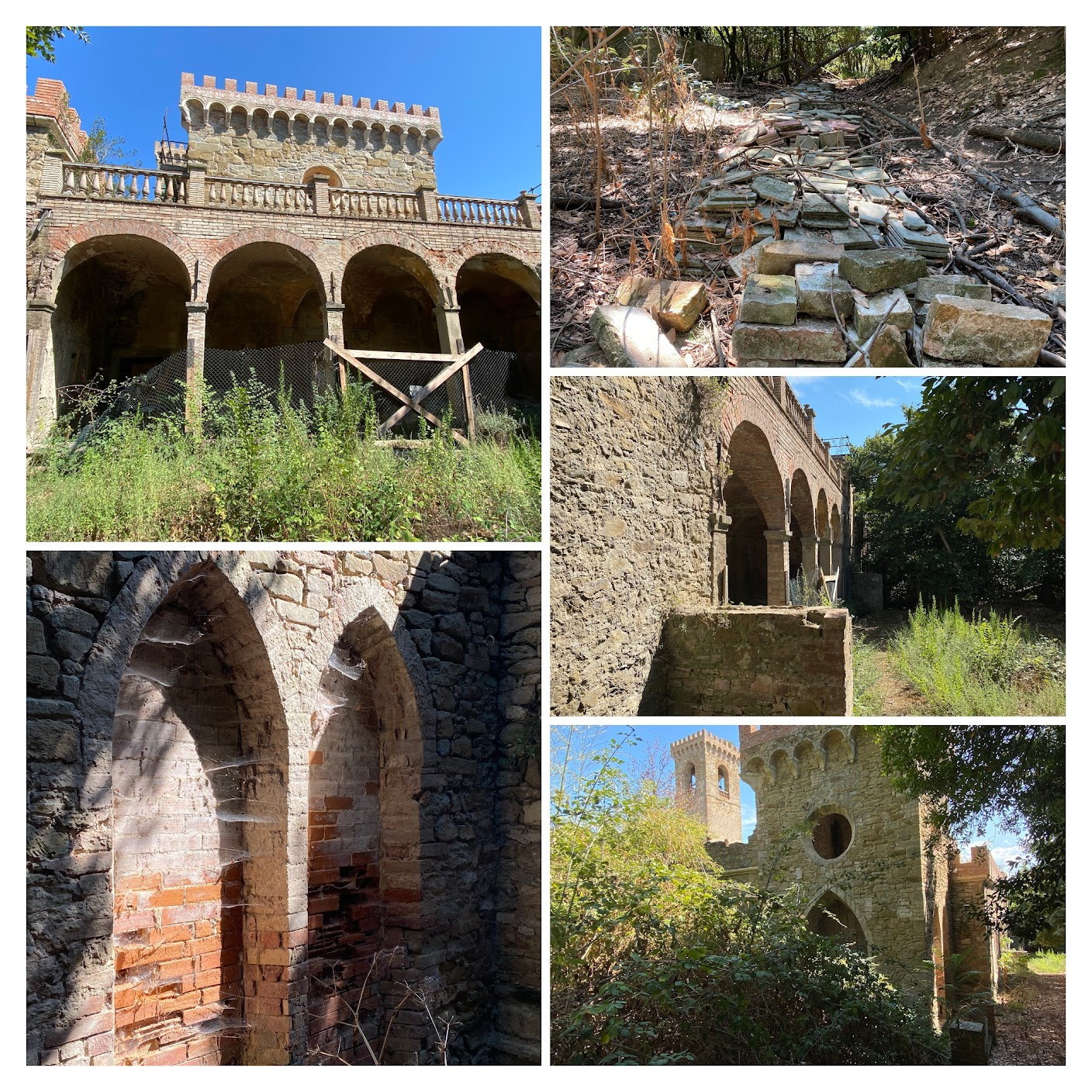
Besides the two iron gates on either side of the property, much of the rest of the property has a huge stone wall. We won’t say how we did it, but we eventually found our way onto the 10-acre castle property. We walked through some dense woods and first came across lots of stone and tile, perhaps set aside as part of the restoration plan and an old foundation. And, then, there it was, the elusive castle, its exterior full of large spider webs and trees and vines growing out of the place. We were a little on edge and really jumped when a large flock of pigeons exited the structure.
And when we sent a photo album of our day to family members, our grandson quickly googled the castle, gave us some of the above details and advised that it was going up for auction. The castle has been on the market for nearly 10 years for as much as $14.5M USD in its current state or $30.5M USD fully renovated into a 5-star resort. As someone who renovated a much smaller hotel before, I believe the latter amount would have been a bargain. Today, you can have it “as is” for $1.5M USD with a minimum bid at next week’s auction of one million euros.

Christie's Real Estate Brochure
Based on the real estate brochure with older photos: The approved project is for up to 150 beds, high level luxury property with beauty farm, sauna, massage rooms, hydrotherapy, gym and laboratories, yacht club, restaurant and docks for ships. It has: crenellated towers, stone walls, frescoes, chapel, theater, Italian garden, parks, wall decorations, wrought iron railings, cloister, Franciscan convent, bell tower, grass tennis court, docking bay and 76 Bedrooms and 76 Baths. Sounds like a steal. That is, until you read words you often don’t see in a real estate brochure for a luxury property: Mold, cracks, filth, ruin, water damage, ceiling collapses, outbuildings without roofs, woodworm damage, destroyed private docks, etc. I am thinking $200M-300M renovation, and I am always low.
Good luck, bidders.
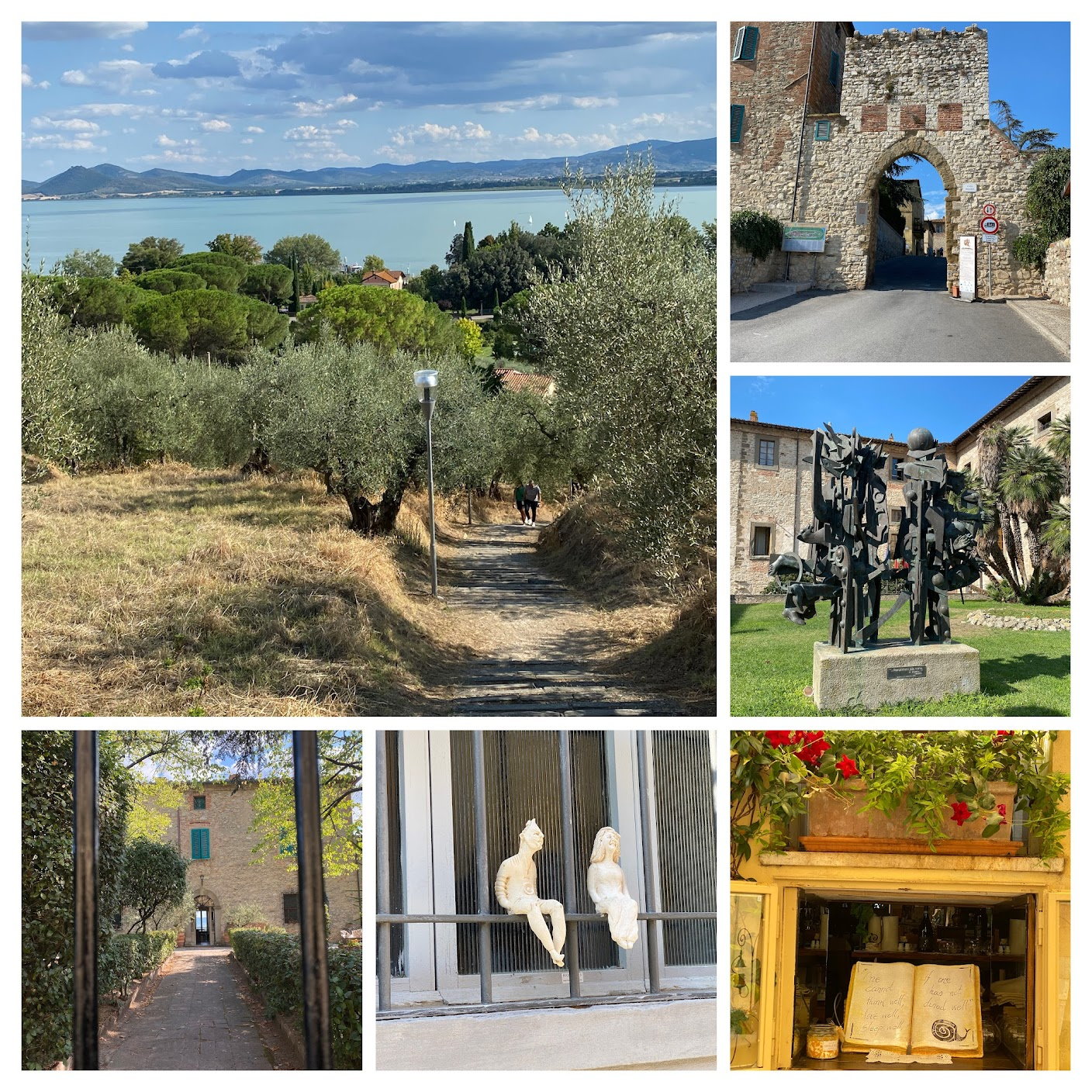
Castiglione
Back to Castiglione for a final look. The purchase of the morning donut was so memorable, we headed back to the bakery, only to find it closed for siesta. So, we settled for a bakery a couple doors down. This one had a little better presentation, a lot more items, and donuts that looked the same. We figured they purchased them from the same supplier. As soon as we lifted their very light bag, we knew these donuts were not from the same place. Not by a long shot. Oh well, next time. And, fortunately, there will be one.
We did get some last minute wisdom, first from what looked like an unusual war memorial (translated: “Survive death and live”) and a restaurant in English “One cannot think well, live well, sleep well, if one has not dined well.”
With the recent rise in fuel prices, we have been trying to adjust to some recent gasoline fill-ups in the US in the $35 range for our small car. After a quick stop at a Lidl store, several hundred yards from the old town, we filled up our gas tank for the first time in Umbria. We went for full service, simply to avoid complications with unfamiliar credit card machines. Our fill-up, with a fair amount of gas still showing on the gauge, was more than $89 USD, based on a full service price of nearly $9/gallon. Regular service was about $8/gallon. This is based on 3.785 liters per gallon, a common price of $1.70E per liter in Umbria (20 euro cent surcharge for full service) and a credit card exchange rate of almost 1.25. Ouch.

Passignano sul Trasimeno
On the way home, we decided to stop at Passignano sul Trasimeno. It had a lively waterfront, with a ferry terminal, parks, amusements for children, snack foods, and, of course, the requisite statue of St. Francis. A nice place to watch the sunset, but, in this case, to watch some waves building from a quick storm that passed through.

With winds picking up, we hustled up to a fortress at the top of the town, just as they were locking its fence for the day.
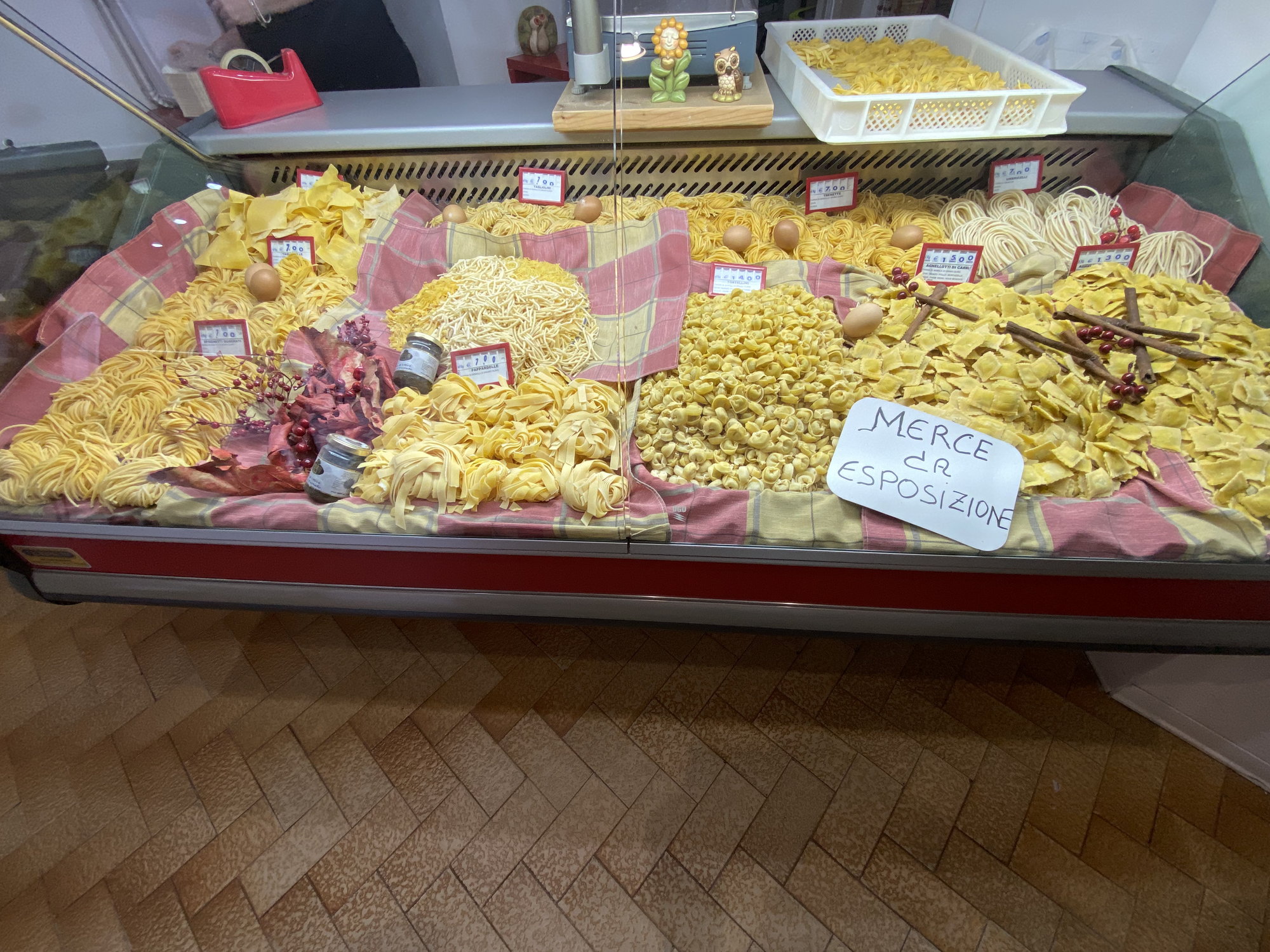
We spotted a fresh pasta shop, and, for a moment, thought of the “no soup for you” Seinfeld routine. We pointed to some ravioli and were told “no”. Well, then how about this one? “No.” Soon, it was “no” to everything in the case. The lady seemed warm, and we didn’t understand why she wouldn’t sell to us. And, after a lot of pointing, and her finally saying “old”, we realized that the case was full of pastas, just for display purposes, not plastic but perhaps days old. She had a couple varieties of fresh pastas available in the back room, and we and she finally laughed as we made our purchase.
#49
Original Poster
Join Date: Sep 2007
Posts: 1,758
Likes: 0
Received 0 Likes
on
0 Posts
Day 10: Bettona, Torgiano, Marsciano & Deruta
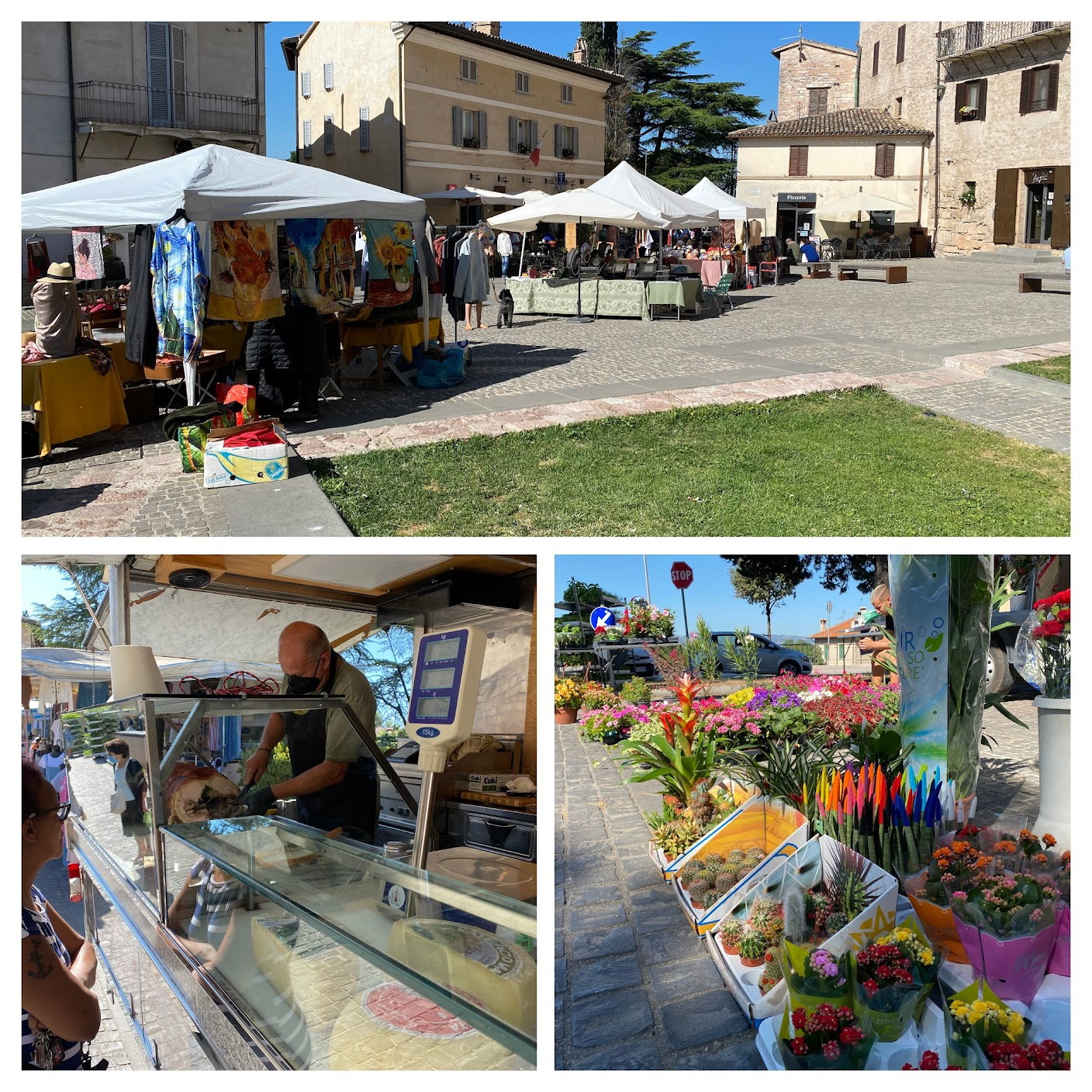
Spello Market
 This first day of September was a Wednesday, our first chance to see the Spello weekly market. Larger than the one in Trevi. Lots of colorful fresh flowers. Another vendor had oodles of herbs, and we saw one elderly woman walk off with a flat of lettuce plants in one hand and a flat of fennel plants in the other. You usually see at least one deli truck at weekly markets (sometimes as many as a dozen at the larger ones) with the butcher slicing pork from a whole pig.
This first day of September was a Wednesday, our first chance to see the Spello weekly market. Larger than the one in Trevi. Lots of colorful fresh flowers. Another vendor had oodles of herbs, and we saw one elderly woman walk off with a flat of lettuce plants in one hand and a flat of fennel plants in the other. You usually see at least one deli truck at weekly markets (sometimes as many as a dozen at the larger ones) with the butcher slicing pork from a whole pig.
In the lower square of Spello, a bus trip of German tourists was preparing to crowd the streets, and we were heading to quieter towns.
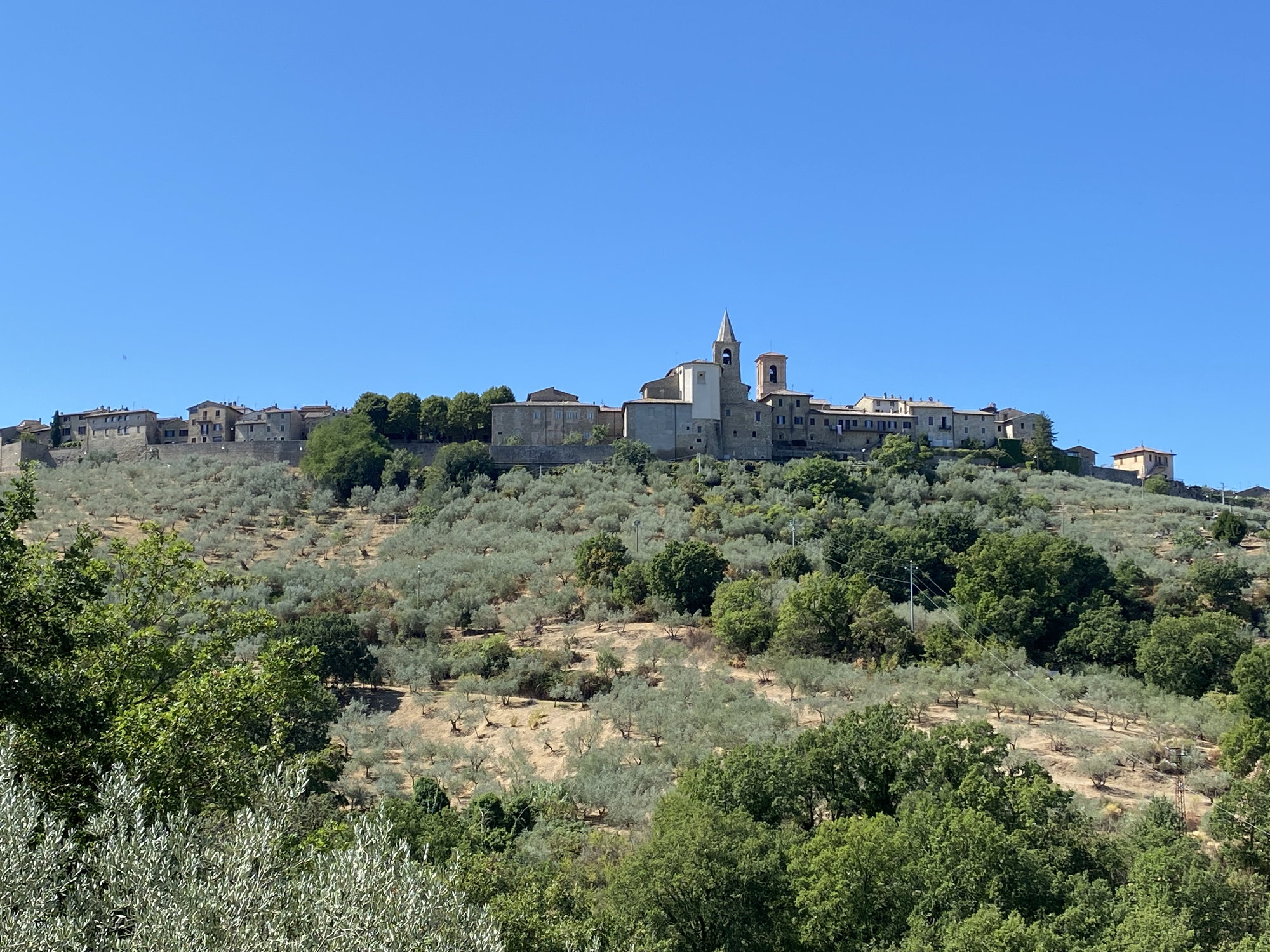
Bettona
First up was tiny Bettona, sitting high up on its hill, and we knew when we saw no other cars on the drive up, this would be a very quiet place. And peaceful.
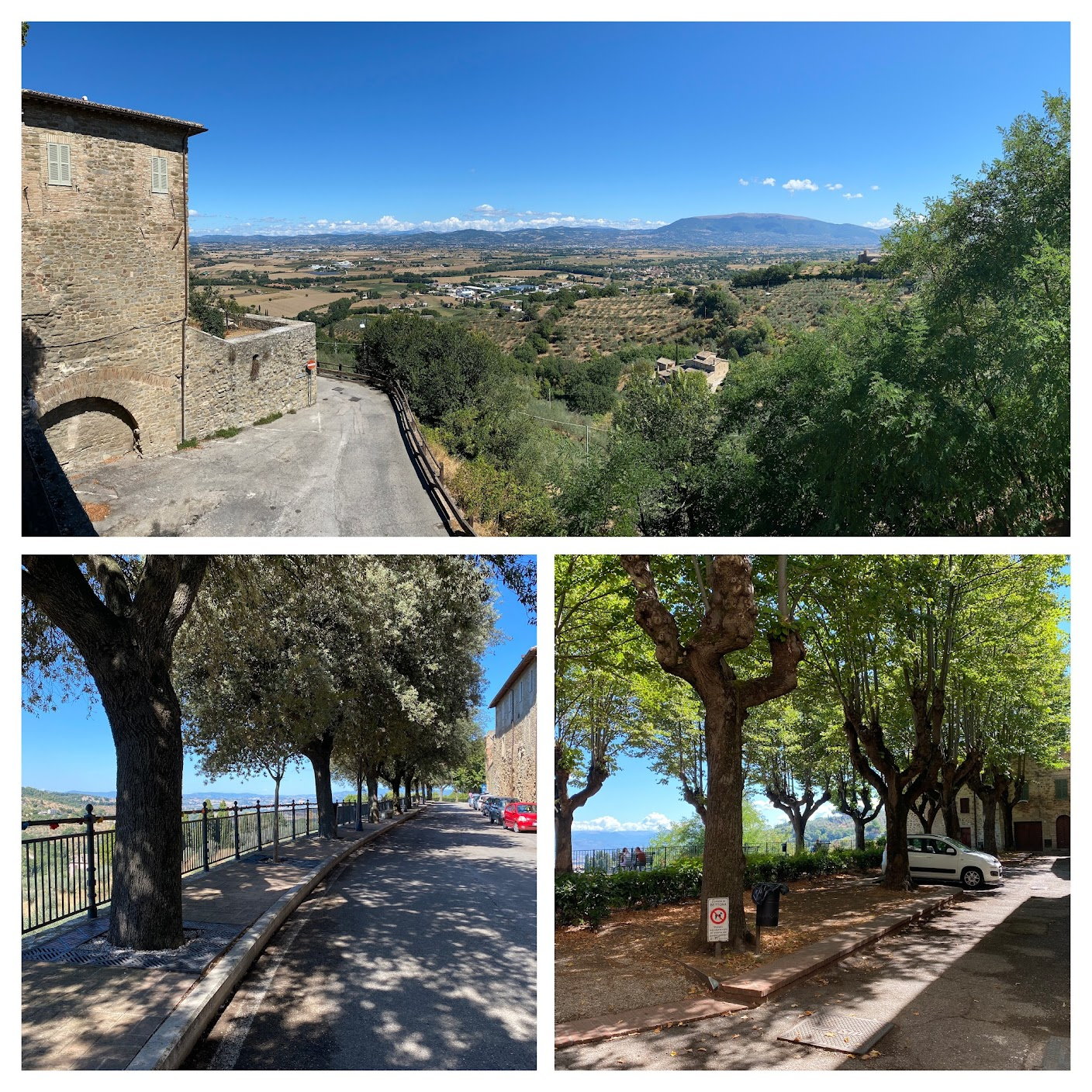
It is difficult to take for granted the sweeping views from these hill towns. Lots of large old trees provided shade in most of the parking areas and view spots and gave the town an estate-like quality.
The iron fencing around the road was covered with crocheted flowers, and many homes in town had similar crocheted flowers and baskets on their doors.
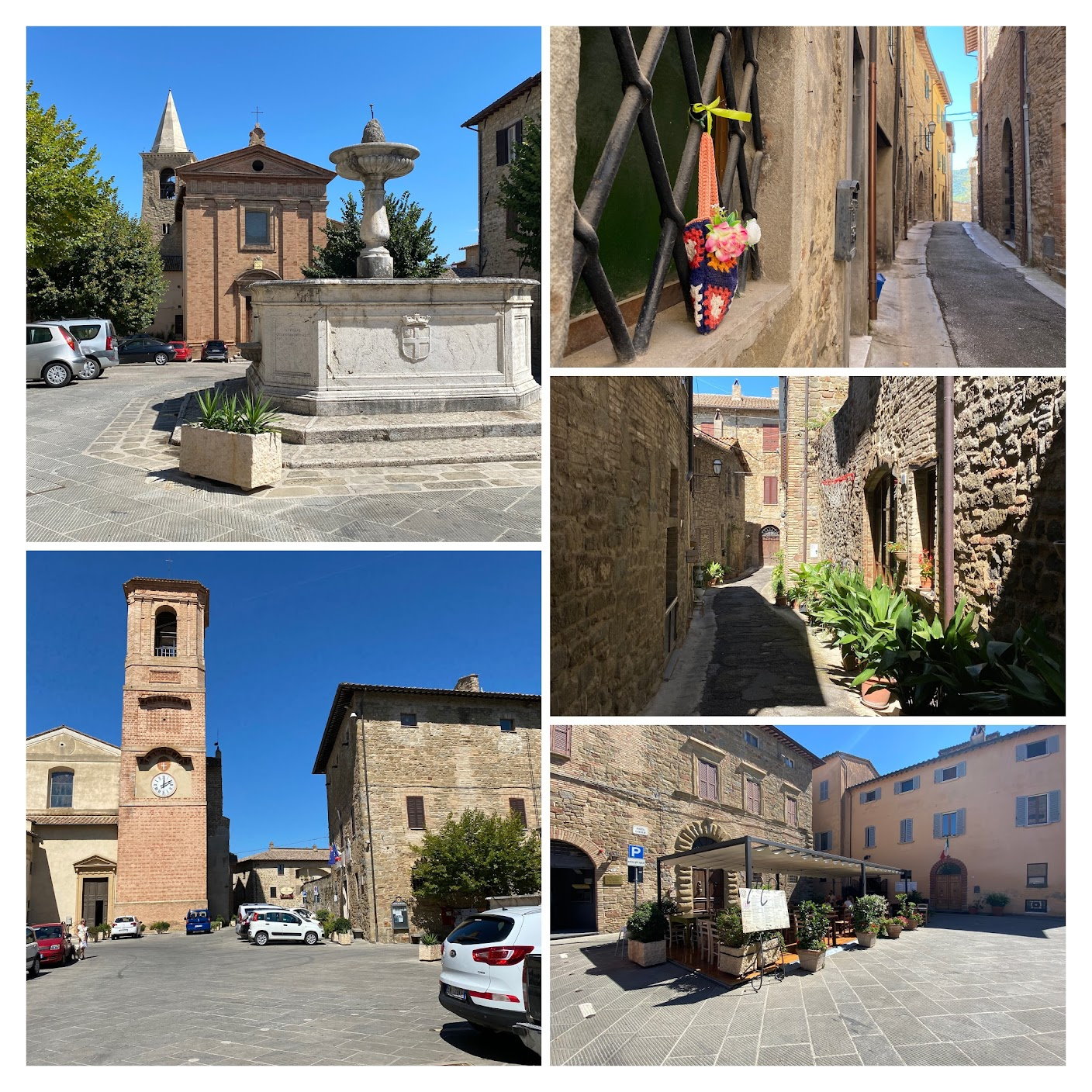 We saw only a handful of people, a couple of them at what appeared to be the town’s signature restaurant, Ristorante da Damiano, with its large outdoor area in the main square; but we also could see a beautiful larger indoor area. Although they seemed to specialize in meat and fish, what’s not to like about a brick oven baked Margherita pizza, at a high end place, for $4.50 E. We also saw a couple other restaurants and a small hotel.
We saw only a handful of people, a couple of them at what appeared to be the town’s signature restaurant, Ristorante da Damiano, with its large outdoor area in the main square; but we also could see a beautiful larger indoor area. Although they seemed to specialize in meat and fish, what’s not to like about a brick oven baked Margherita pizza, at a high end place, for $4.50 E. We also saw a couple other restaurants and a small hotel.
As the only tourists there today, we took the time to visit the St. Andrea Oratory. The description of that tiny space is typical of the thousands of little churches around Italy, but perfectly describes the photo:
“First built in the 12th century, the present Baroque style is a result of several successive restorations. The beautifully coffered ceiling decorated with finely carved roses is a work by Benedetto from Montepulciano (16th century); the high altar dating back to 1700 has a refined stucco decoration shaped like a fine drapery, which surrounds a painting illustrating the martyrdom of St. Andrew, which belongs to the school of Cortona (18th.century). The late Giottesque frescoes date back to 1394 and represent Christ’s passion.”
We read that an Etruscan town was here before the Romans came, but there are little remains of anything before 1352 when a Perugian army destroyed the place.

A random question. We see copper pipes and gutters all over Italy. We cannot fathom the cost when we see refurbishing and new projects. Is there something we are missing? Is there something that looks like copper but costs less?

And, of course, there are some things you just cannot replace, like this religious scene fashioned over someone’s doorway.
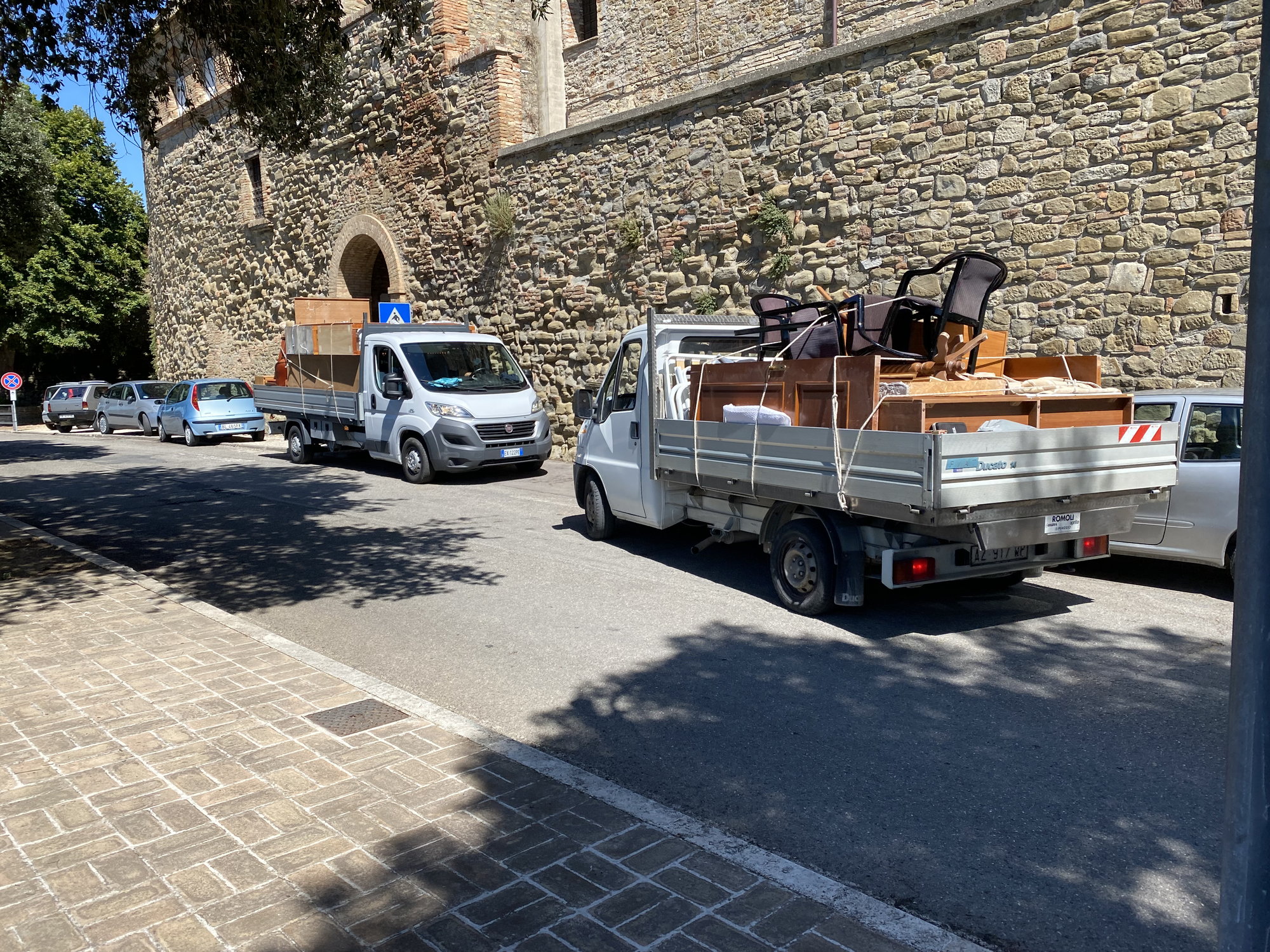
As we headed out, we saw these furniture movers and had it hit us what a job it must be to move in or out of a small hill town. And, in typical Italian fashion, even this apparently small move caused several people to get into a long animated discussion about the best way to get these items up some narrow passage ways.

Torgiano
We just noticed that our, in our first post on this thread, the initial list of Umbrian towns to be covered in this report failed to include Torgiano and Marsciano, two places we quickly visited today, both frankly forgettable.
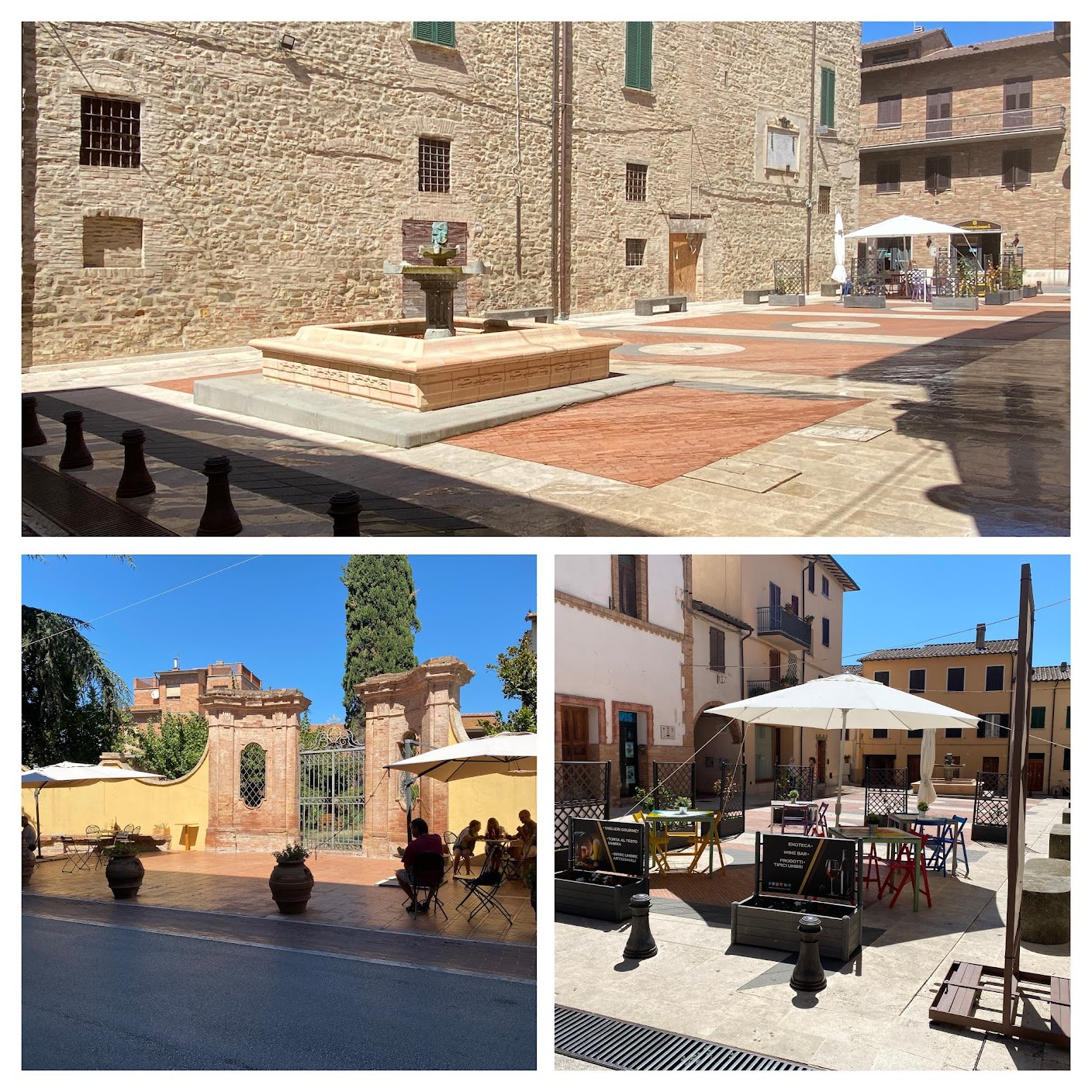 It was a warm sunny day, and the several clean and neat squares, providing little shade, were empty.
It was a warm sunny day, and the several clean and neat squares, providing little shade, were empty.
We had hoped to visit a highly regarded wine museum in a perfect looking large three-story stone building. We walked in, handed the only person in the place our credit card. He looked at his watch and said he was closing.

Just like Bettona had a crochet flower theme, Torgiano had painted tin cans, with fresh flowers, all over.
Siesta was not a good time to be in a town that obviously attracts few tourists, as everything was closing.

We were surprised to see a large 5-star hotel. And, we checked, most of their rooms are $500/night. As former hoteliers, we aren’t sure how they are doing it. We will stick with our gorgeous $85/night two-story apartment in Spello.
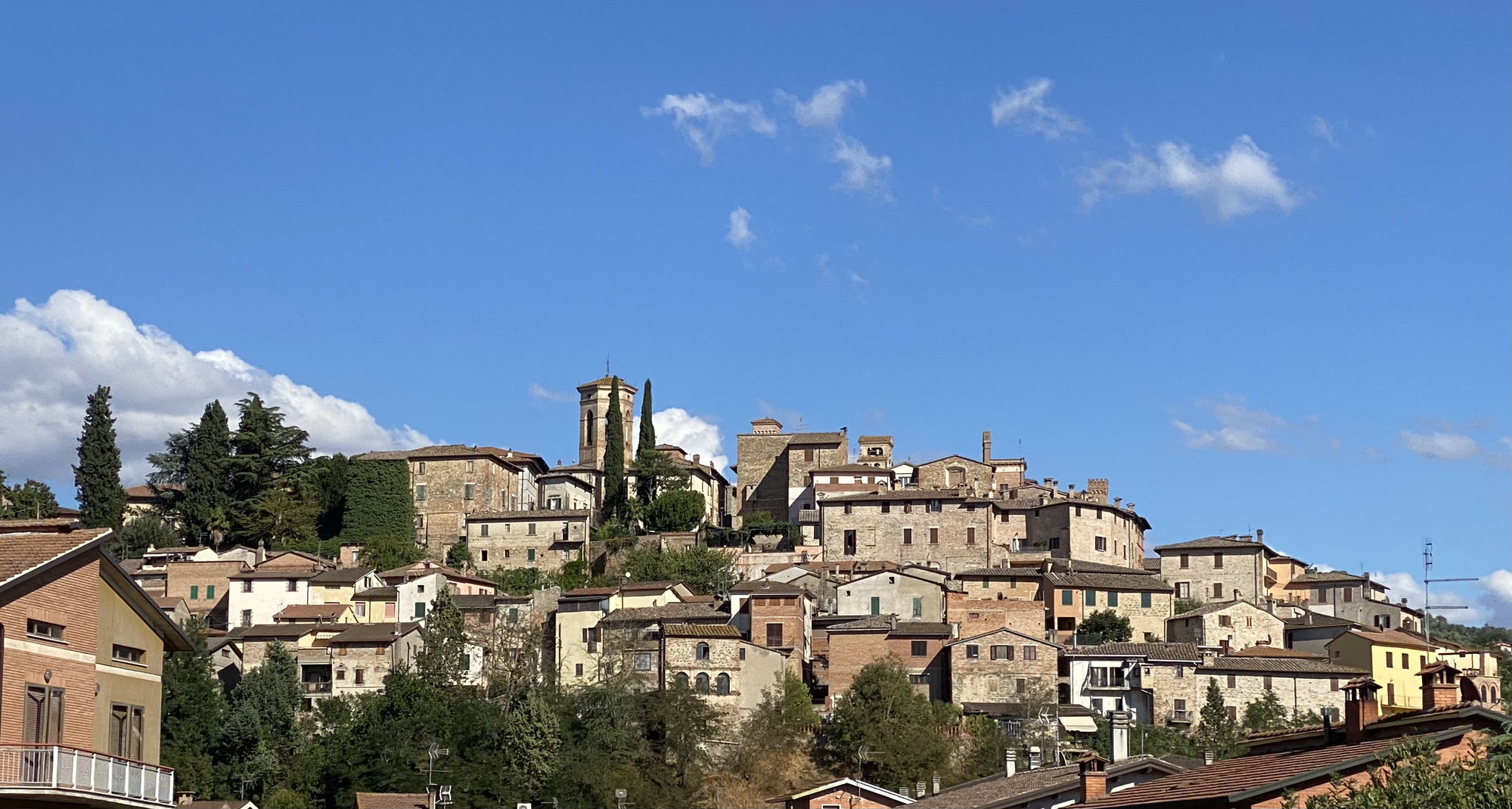
Marsciano
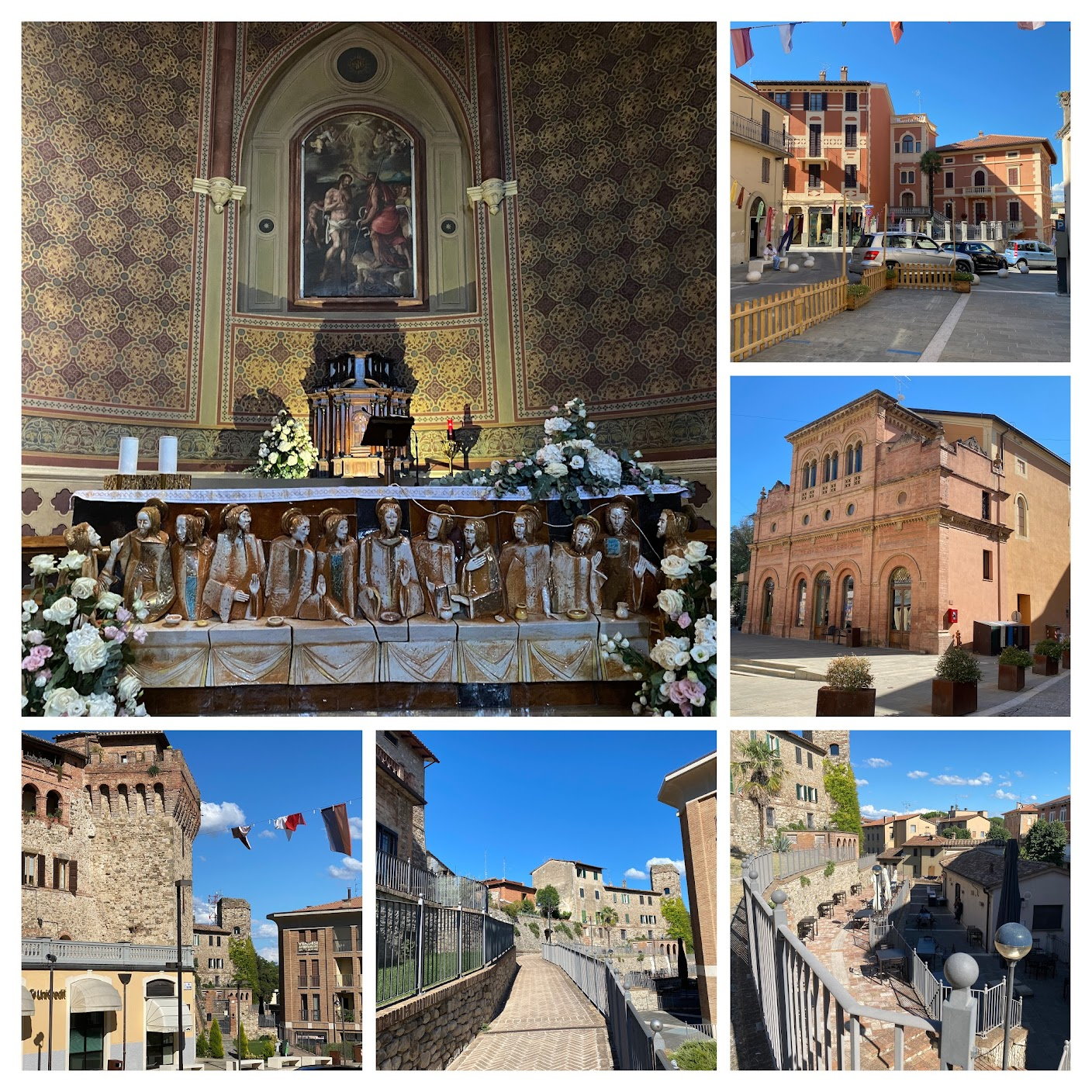
Marsciano didn’t offer much for us. An interesting church with a wood tabernacle from 1700. There is reportedly a major brick manufacturing facility that includes a museum. Most of the older buildings in town are stone, but the striking old theatre does have a brick facade. Behind that facade, we have read that it now houses a modern cinema. That speaks a lot about this town that seems to be largely a mixture of old and new.
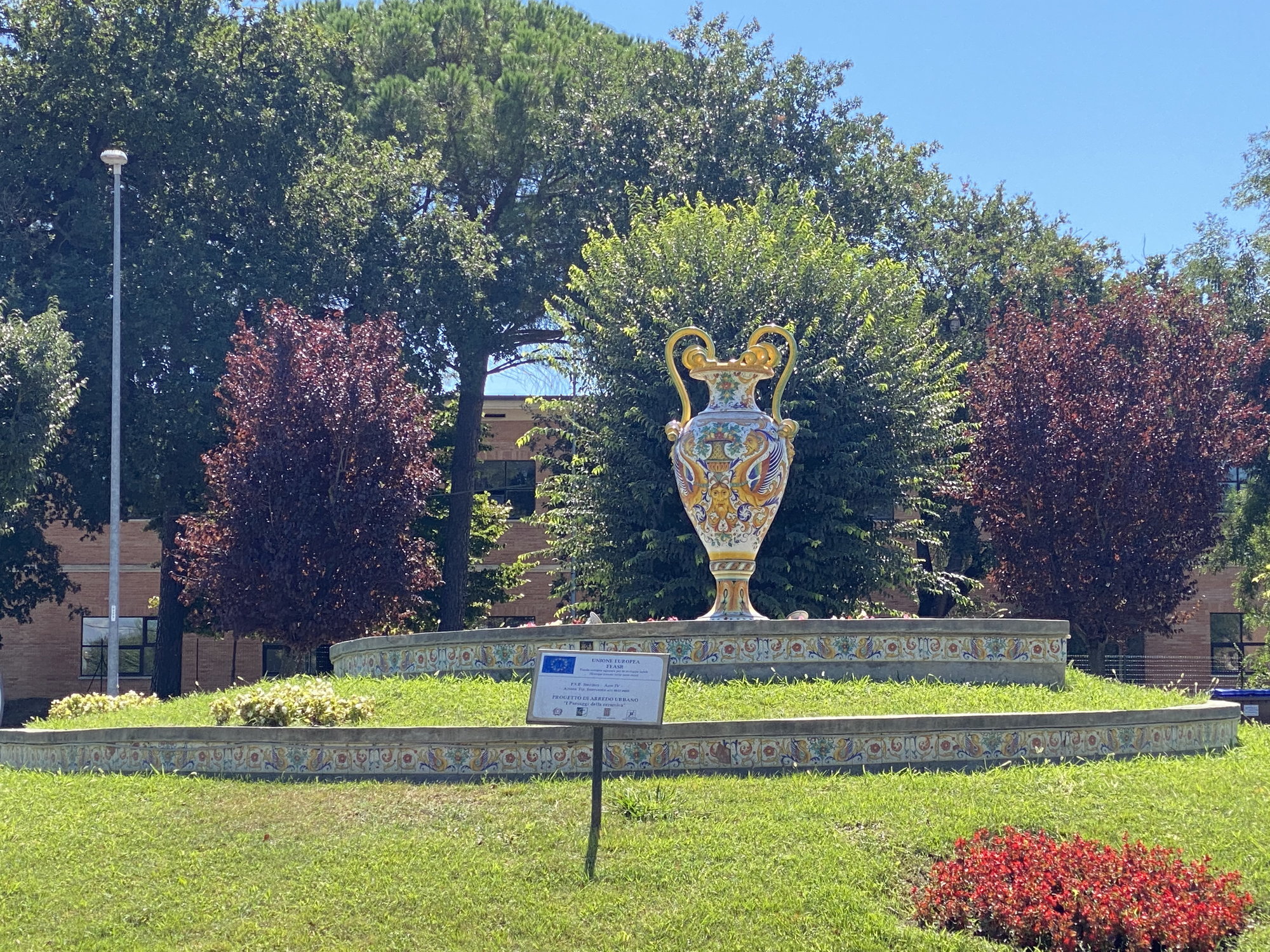
Deruta
There are other ceramics centers in Italy, but this industry is the center piece of the small town of Deruta. The welcome rotary to the town is a giant ceramic urn.

There are many large factories creating ceramics in Deruta. I don’t know, but I have to believe some of them might be producing machine made ceramics. However, there are reportedly many, if not all of them, that produce high quality ceramics that one site says: “it was turned on a potter’s wheel by hand, trimmed by hand, high-fired, dipped in white glaze, hand-painted with various pigments, coated with clear glaze to protect the designs, and then high-fired a second, sometimes even a third time for extra durability.”

This ceramic in a Deruta church shows how important the industry was here in 1919.
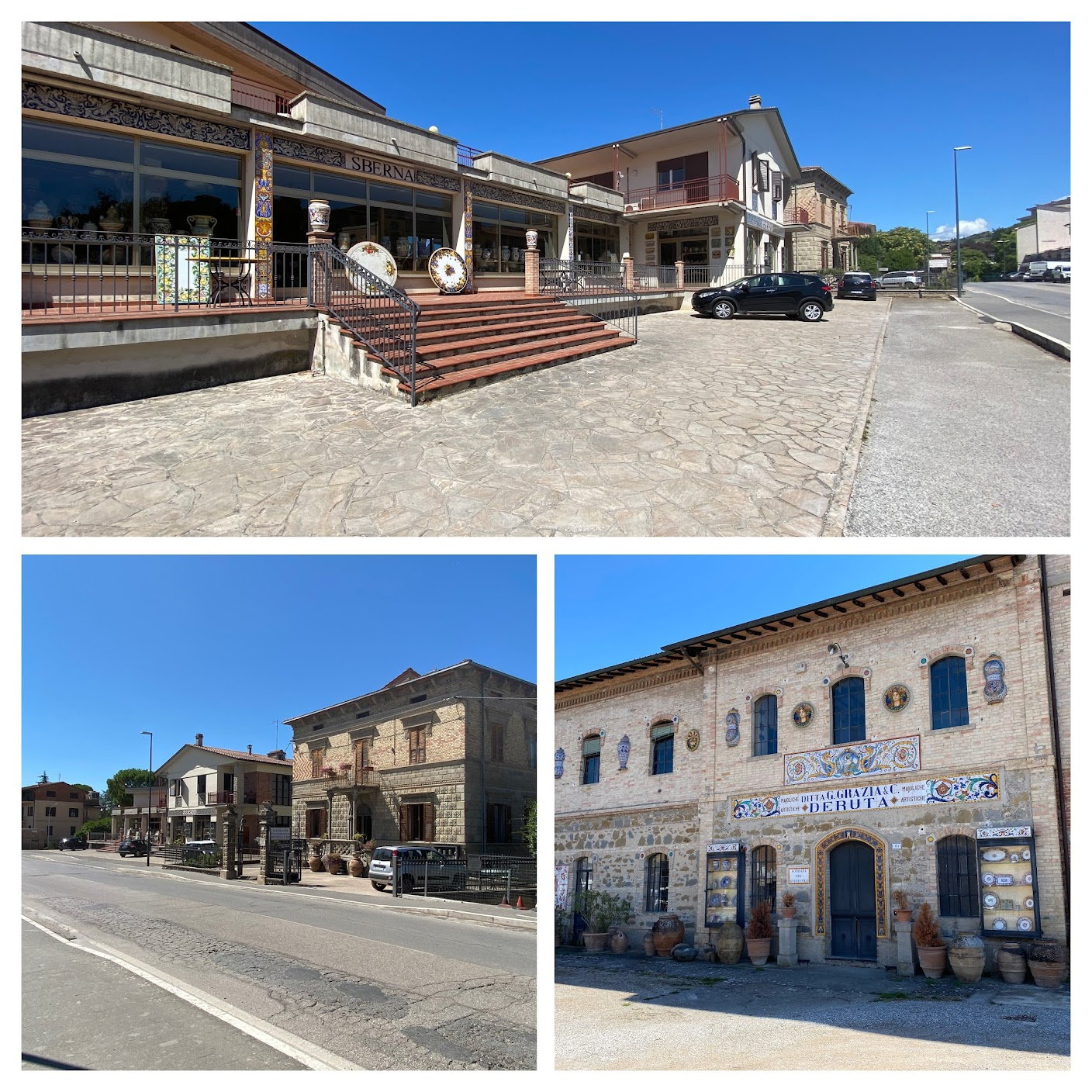
There are numerous large retail outlets for ceramics outside of the old town. Parking lots were empty. Some stores were closed.
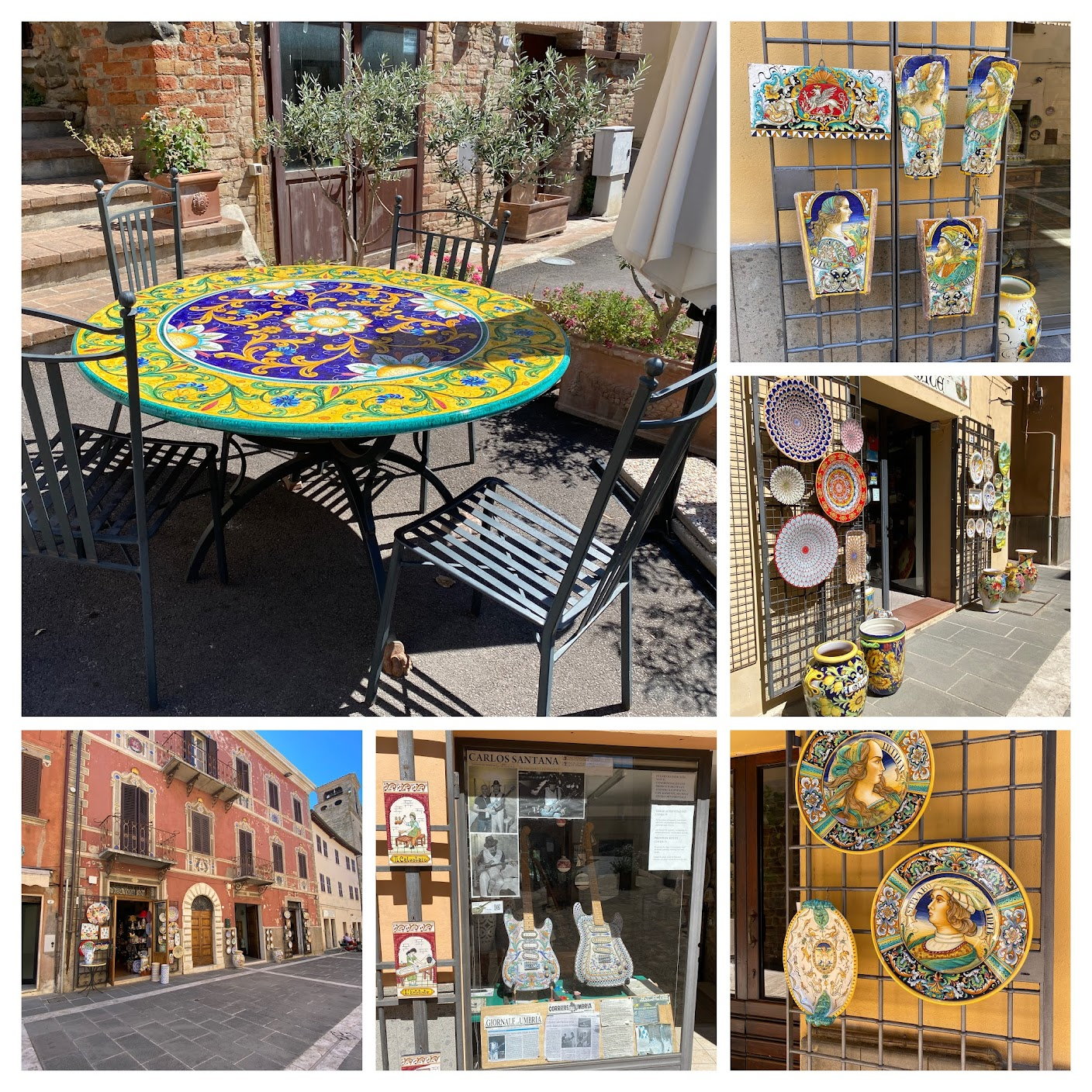
In the old town, many retail ceramics stores were open. The products are beautiful, but again the town was very quiet; the stores were empty. The most unusual retailer was showing off these magnificent guitars that apparently made Carlos Santana a customer.

In Deruta, it is everything ceramic.Tomorrow, we go to one of my new favorite towns in Umbria.
#50
Join Date: Jun 2008
Posts: 29,619
Likes: 0
Received 0 Likes
on
0 Posts
Still following along, whitehall. We hit Deruta at lunch time and little was open. In the few studios we saw, it looked like designs were printed in gray on the ceramics and being colored in. So who did the gray designs?
#52
Original Poster
Join Date: Sep 2007
Posts: 1,758
Likes: 0
Received 0 Likes
on
0 Posts
#53
Original Poster
Join Date: Sep 2007
Posts: 1,758
Likes: 0
Received 0 Likes
on
0 Posts
Day 11: Gubbio

Gubbio
This is our second trip in three days to the far northern corner of Umbria. We considered taking a train, but it doesn’t go to Gubbio. This may make Gubbio a less attracrtive destination for many (if you don’t have a car, you can get within 12 miles or so on rail and then you need a bus), but the result is a magnificent city with no crowds.
We parked in a lot adjacent to Piazza dei Quaranta Martiri, named in honor of 40 citizens of Gubbio, who were murdered by Nazis in retaliation for a nearby partisan attack that killed one German officer in 1944.
Gubbio is full of well-preserved Medieval architecture, but its history goes back to Roman times, making it one of the oldest cities in Umbria.
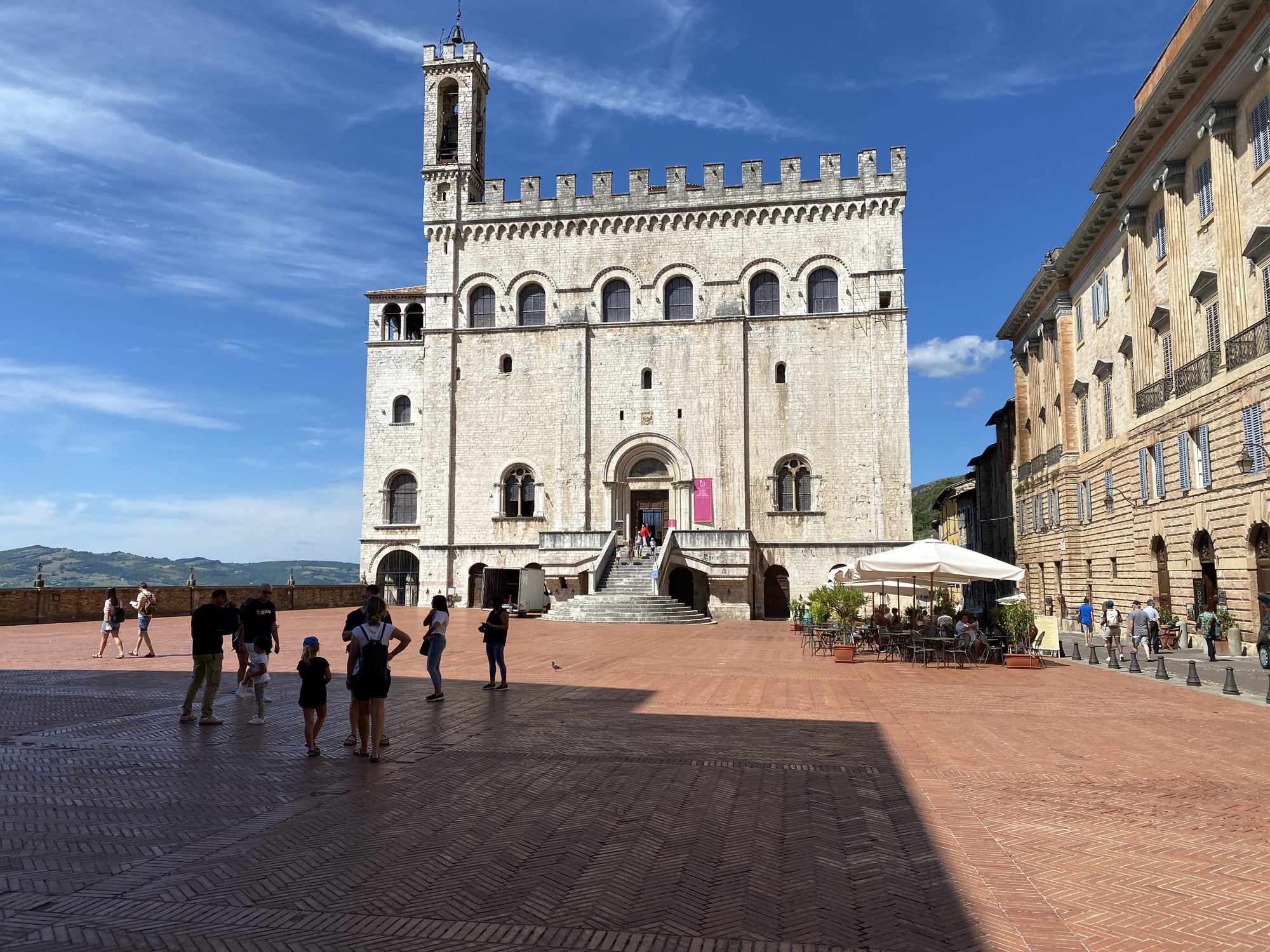
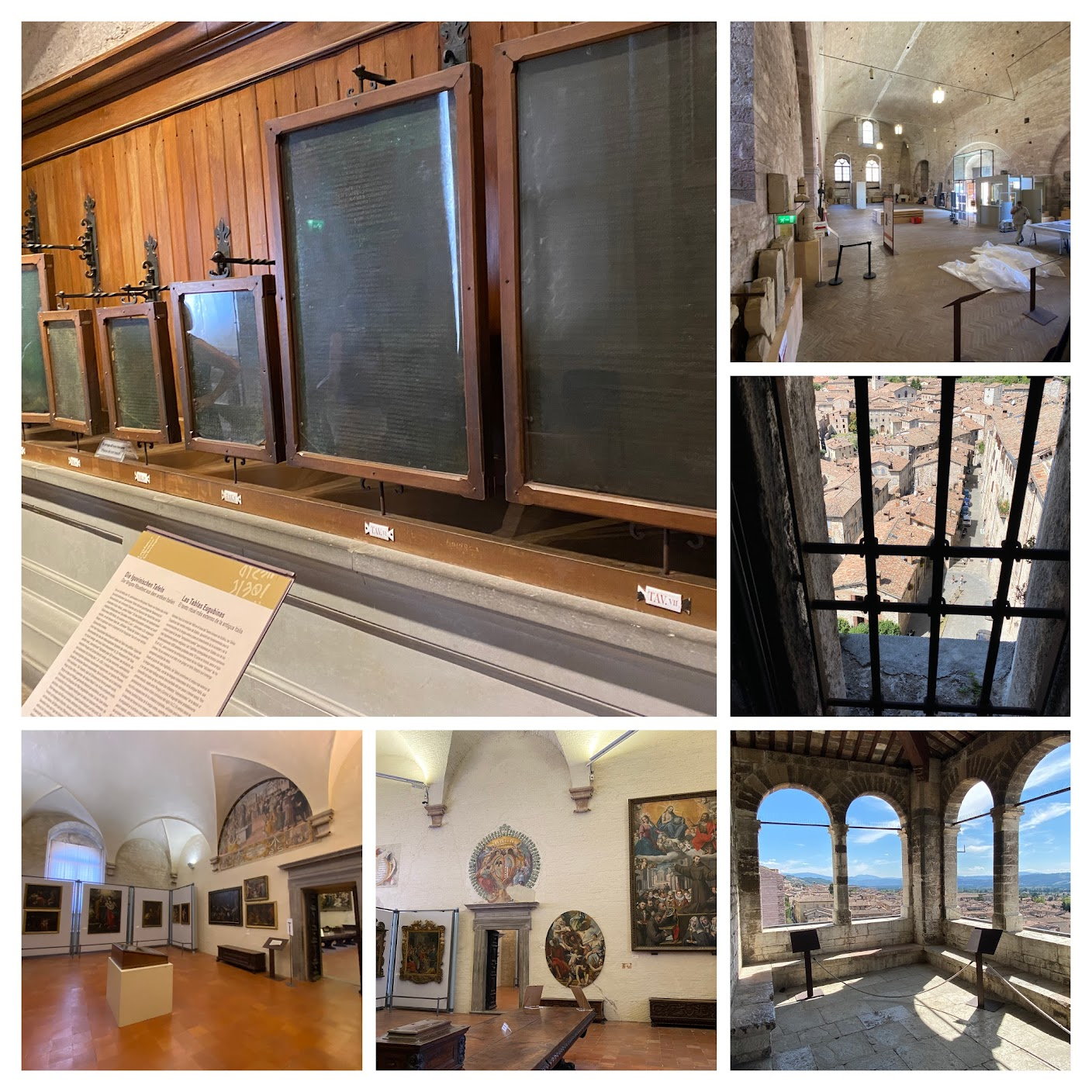
A short uphill hike puts you in Piazza della Signoria, a square that some consider a major engineering feat in its day. It is a perfectly large and flat area built on a steep mountainside. The Civic Museum in the Palazzo dei Consoli is a stately public building from the 1300’s. We showed our green passes, and, although an exhibit had just ended in the large main room, there were plenty of art, historical artifacts and views to make the visit worthwhile. One of the most popular exhibits are the Iguvine Tablets, which were seven bronze tablets discovered in Gubbio in 1444. The earliest ones were from 300BC and are written in an Umbrian language that no longer exists.
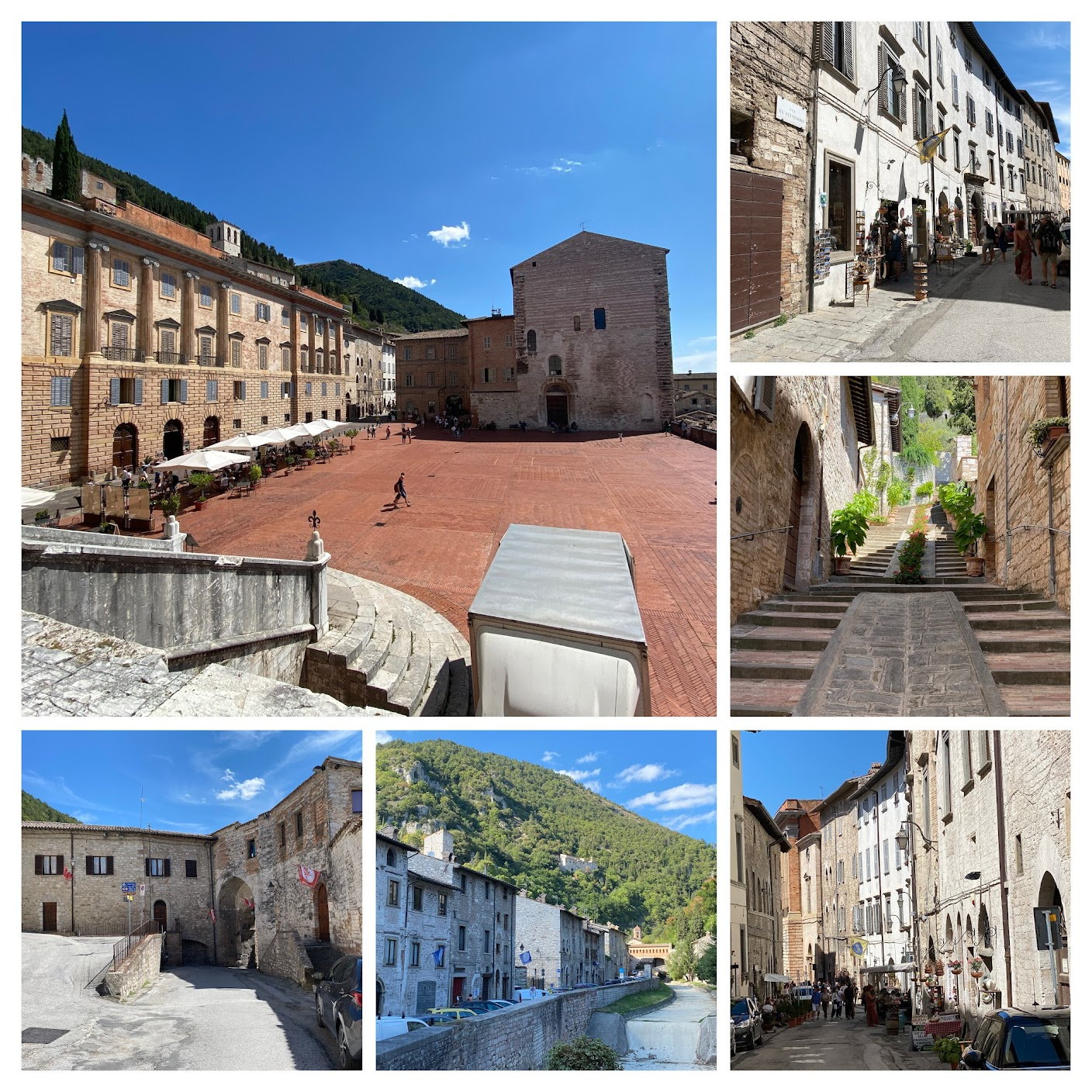
Gubbio is known for several things but its well-preserved medieval architecture is front and center for what is one of the oldest cities in the region.
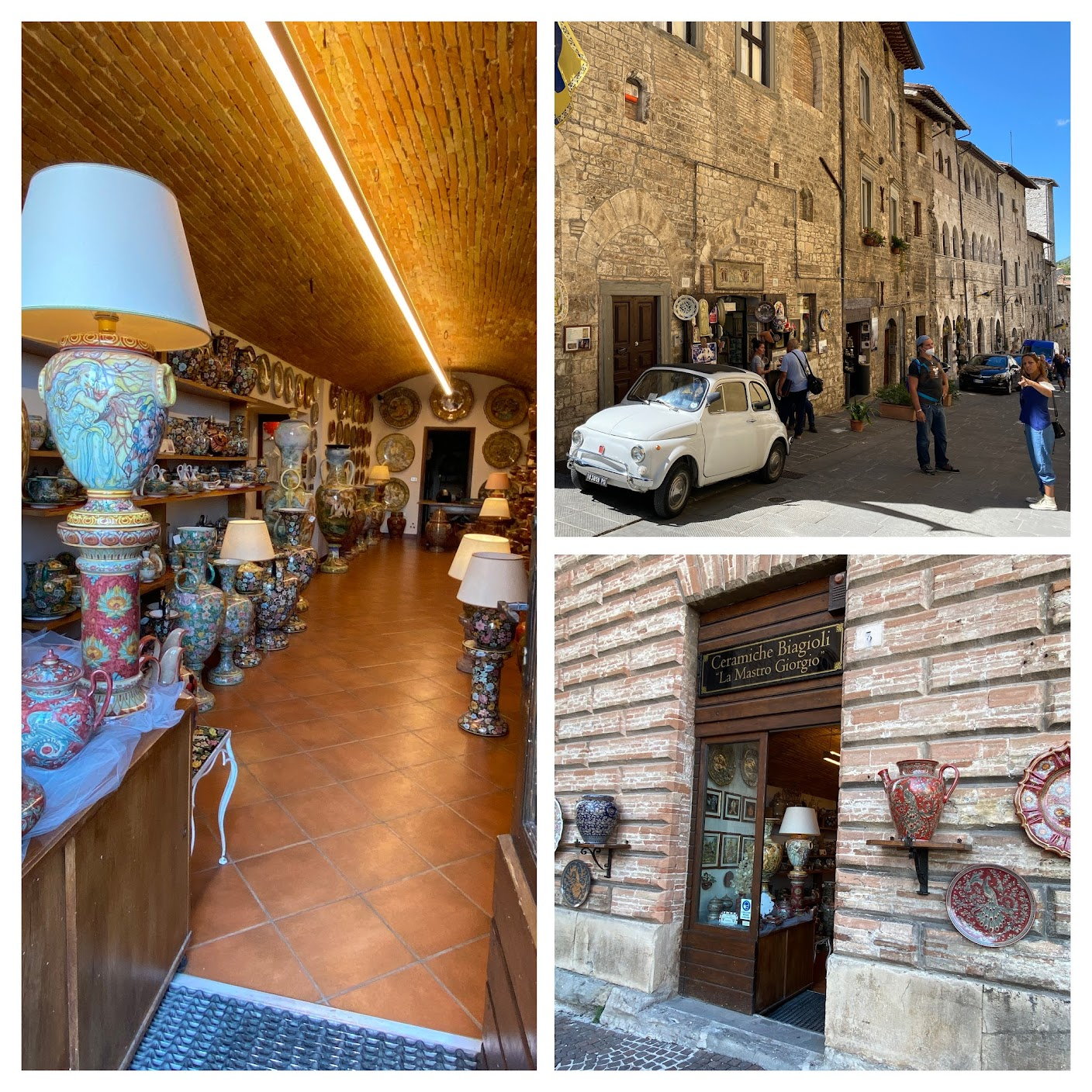
We saw a lot of ceramics, at first believing them to be from Deruta, but Gubbio has a well established quality ceramics industry itself.

A lot of Italians are familiar with Gubbio only through Don Mateo, a popular Italian TV series about a fictional priest from Gubbio who teams up with a police detective to solve crimes. For many years, it was filmed in Gubbio (and some of the episodes are available on Amazon), and even today a hotel there proudly displays a simple set from a 2012 episode. Later on our trip, we happened onto the set of the latest iteration of this long running show, and we will include an update at that time.

On our must do list was finding the Colle Eletto “bird cage” cable “cars” that go up Mont Ingino that provide the backdrop for this remarkable city. We had to walk to one end of the town to find them and were surprised that there were few riders on this beautiful day. My wife is a bit skittish about cable cars, especially after the recent accident on Lake Maggiore (which we passed on a couple years ago when the attendant there told us he could send us down but couldn’t promise to get us back later because winds were picking up).
You have a choice of riding as a couple (it is very tight) or individually, and it was decided we were going together. There is some choreography, since the cable and cages are always moving. We had to stand about 15 feet apart on the platform, since there is only time for one to mount the cage before it moves on for the second person to jump on.
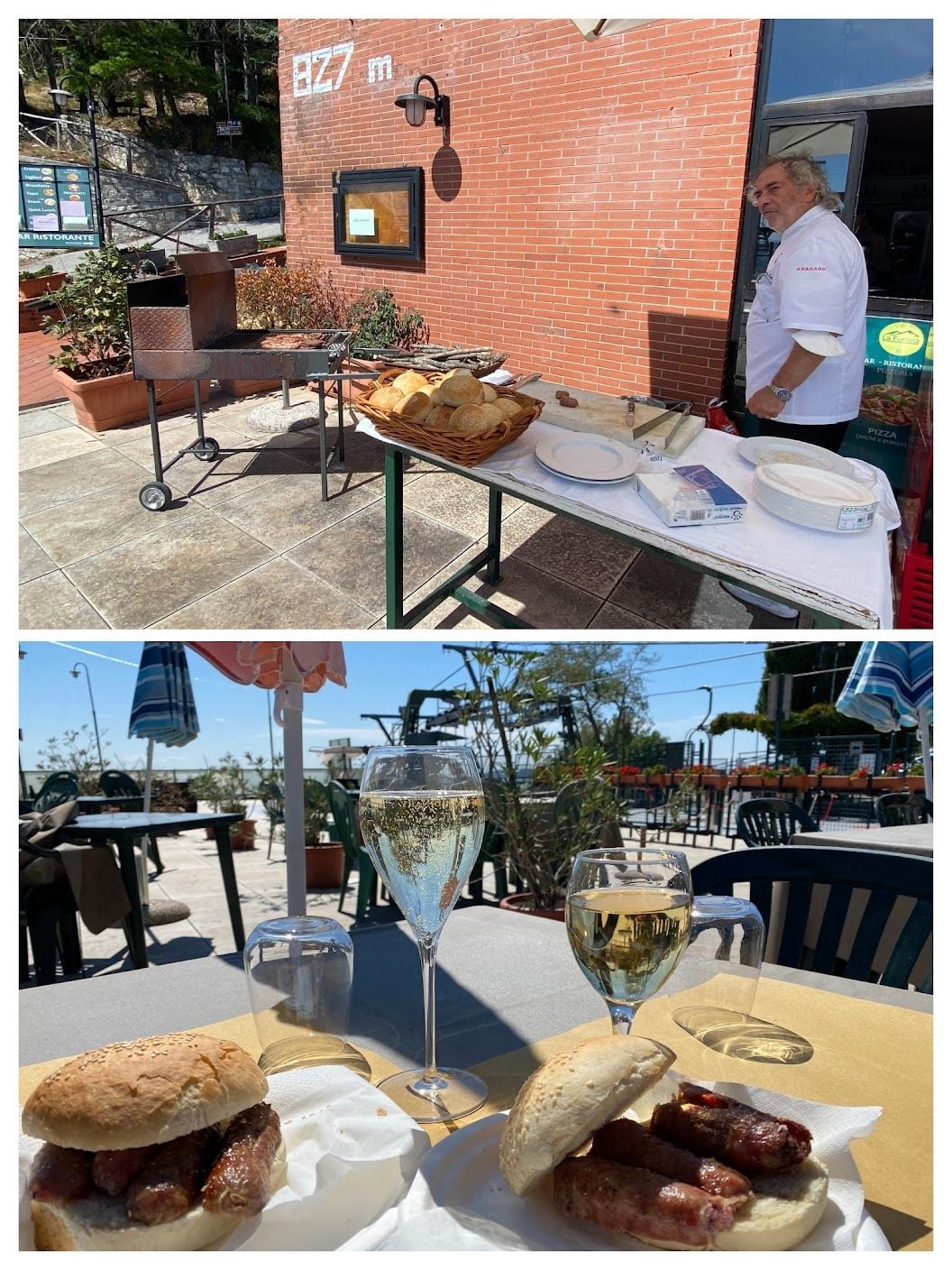
As we dismounted, we saw what we thought was the usual snack bar at the top of this type of amusement, except there was a man in a chef coat and a grill, and it smelled really good. We soon were seated by the elder owner, who spoke no English. Soon, he sent his son Giuseppe, who speaks English, to wait on us. We had what turned out to be a very delicious grilled sausage sandwich, which he recommended we eat without sauce, mustard or anything else except bread. The sausage was so good, it didn't need anything else, except for some nice wines. Little did we know this was the place for wine. Giuseppe, as it turns out, pre-Covid, helped his father out during the warm season and then lived in New York City the rest of the year, as an Umbrian wine ambassador, covering the east coast of the US. Fascinating and friendly guy. And this “snack bar”, far from it. Besides the large terrace where we had lunch, there was a beautiful restaurant and bar, and underneath an event space, with mountaintop views, for groups up to 300. We kept in touch with Giuseppe and in the next week, he would give us recommendations for wine tastings.
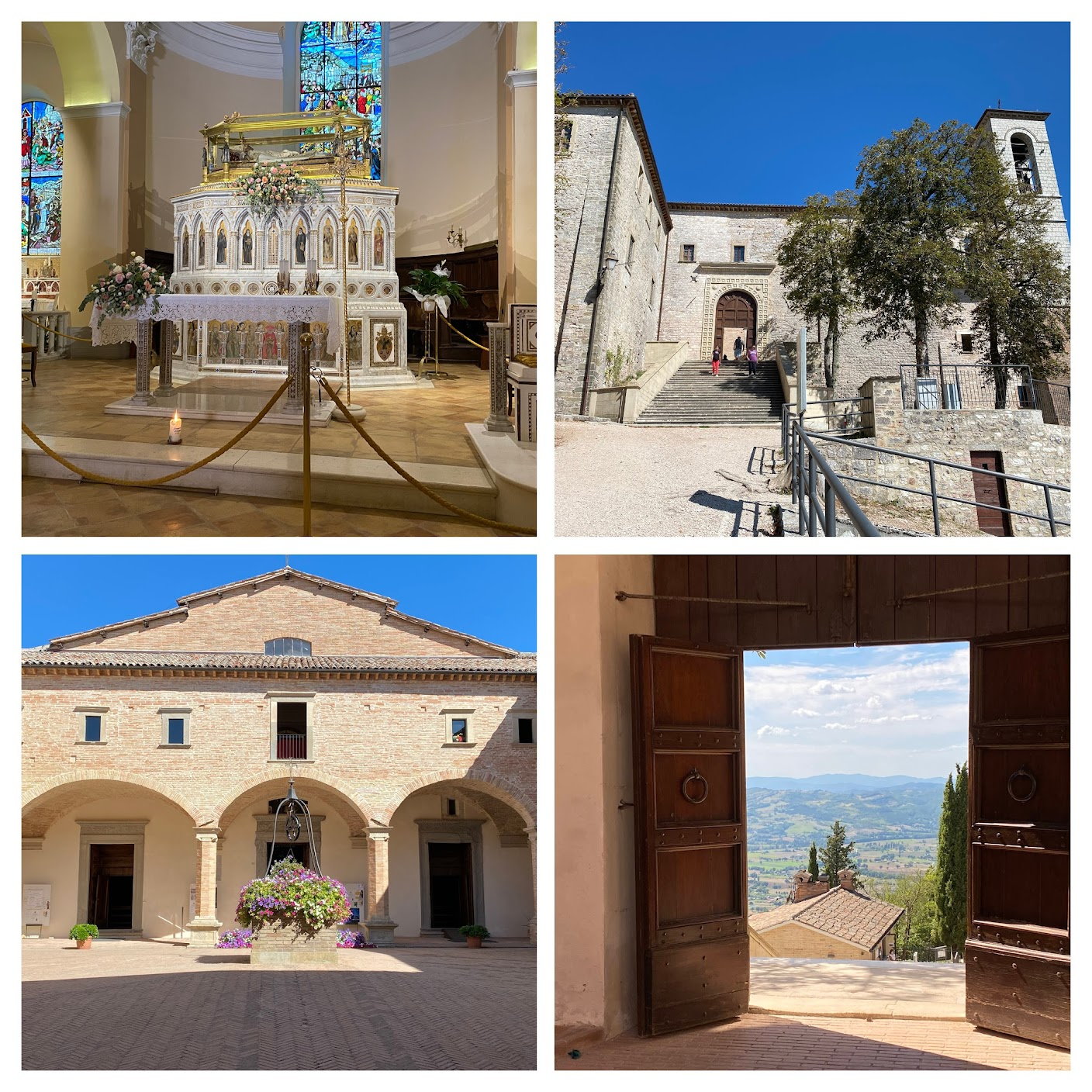
After lunch, we took the short hike up a little higher to a the Basilica that sits well above Gubbio. The body of St. Ubaldo, the patron saint, of the town sits atop the altar at the Basilica named for him. His body miraculously has not decomposed, similar to the Spanish wayfarer’s body we saw on Day 4 in Montefalco.

Ceri are hollow, but heavy, wooden supports for statues of three saints, that have been carried through the streets of Gubbio and then up Mont Ingino to the Basilica each May for nearly 1,000 years. They keep them in the Basilica, except for the day of the procession from town.
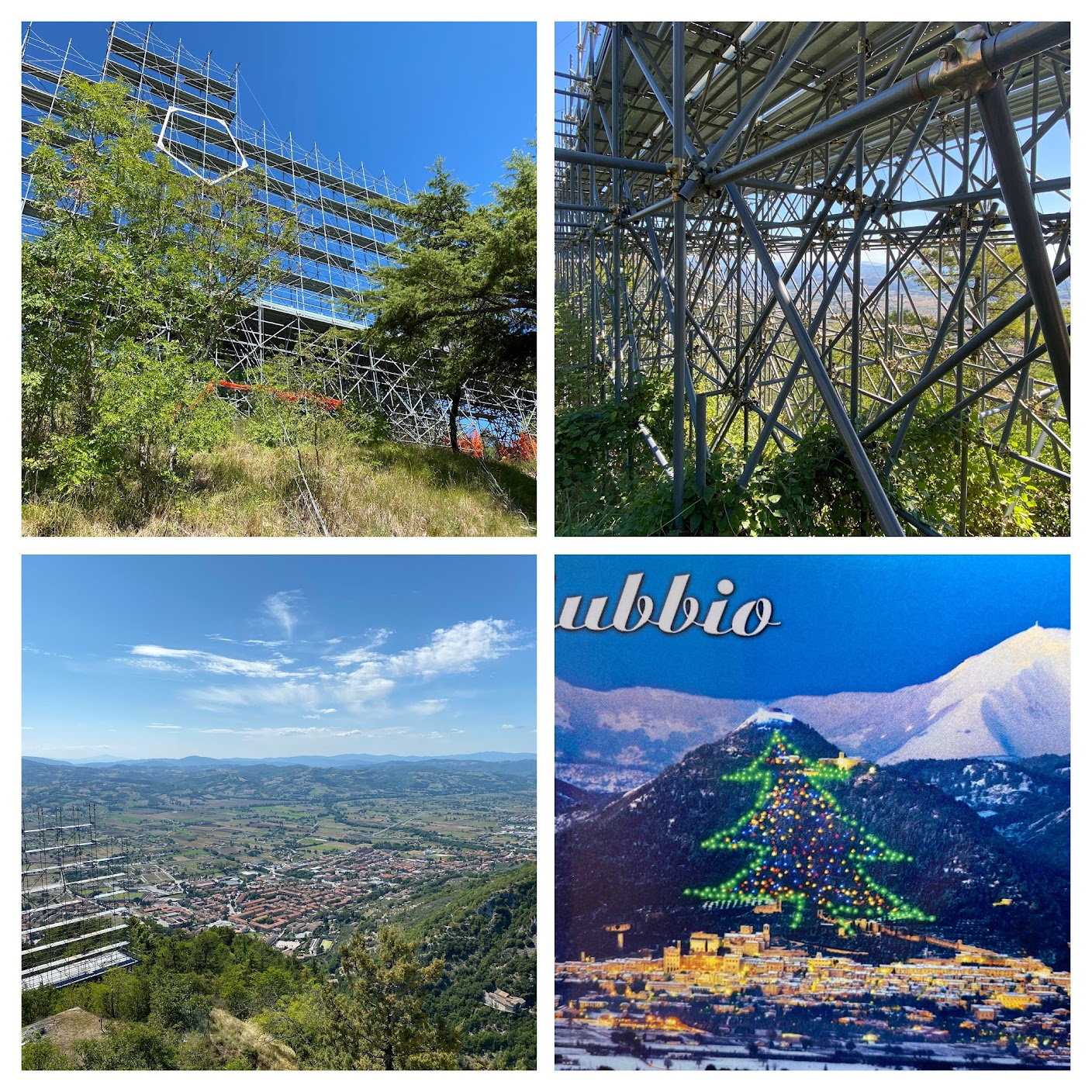
It is on the side of Mont Ingino where the claim has been made that they have the world’s largest Christmas tree. From the postcard photo above, you can see that they string lights from near the top of the mountain down to the town. They say 450 lights, so they must be really big ones.
We took an unmarked path up from the Basilica and found ourselves under a massive scaffolding-like structure that must be related to that famous tree. Maybe it holds the star; maybe the whole thing is connected to it.
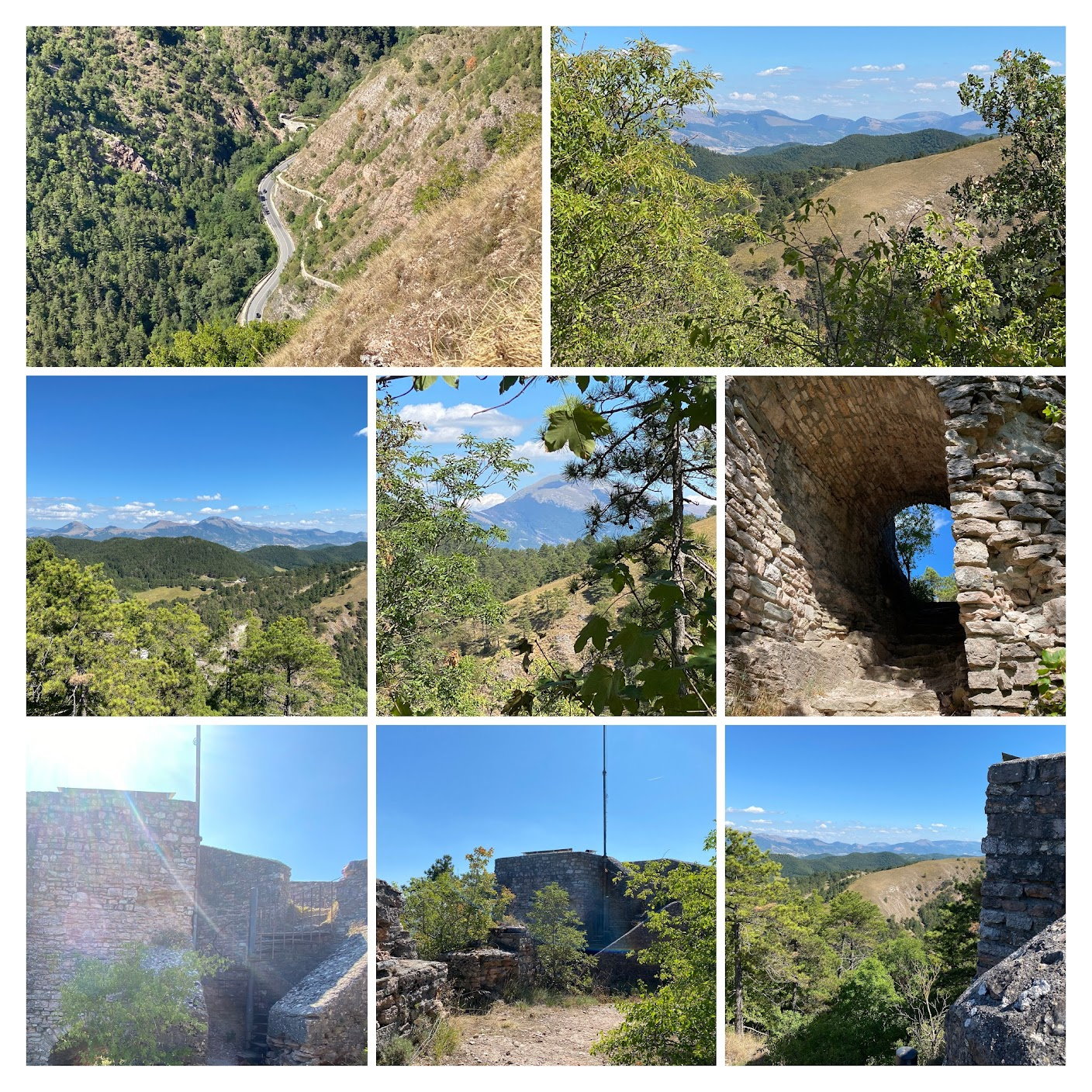
Again, without markings, we found a rough path to get to the top of the mountain and there we found an old fortress and some ruins. Most of the small number of people on the main path were missing this, and we pointed to it to a few of them.
From here, the views of the Apenines and the city of Gibbio were exceptional.
Although we had a round trip ticket on the bird cages, we walked about halfway down the mountain when we had second thoughts and went back for the cable descent.
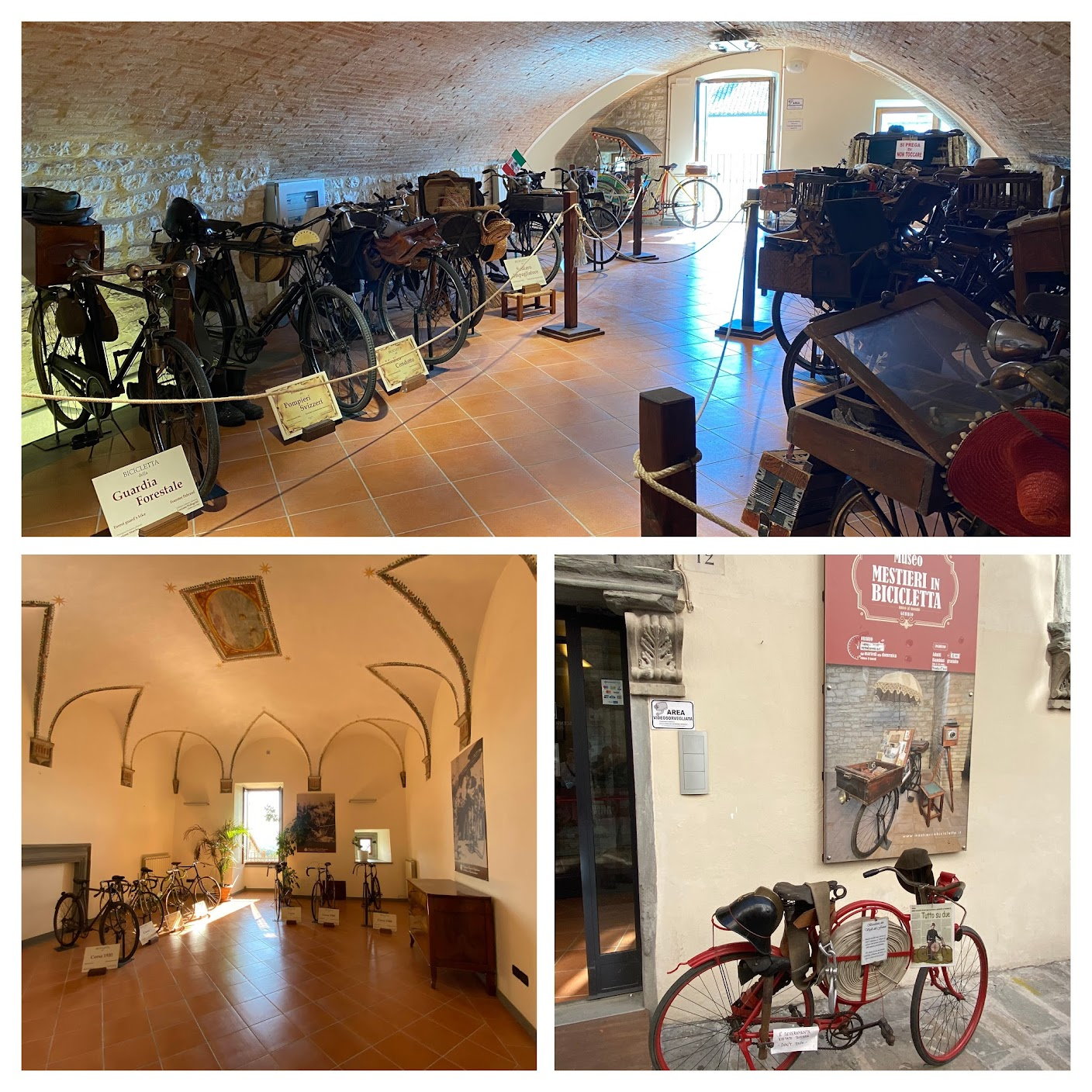

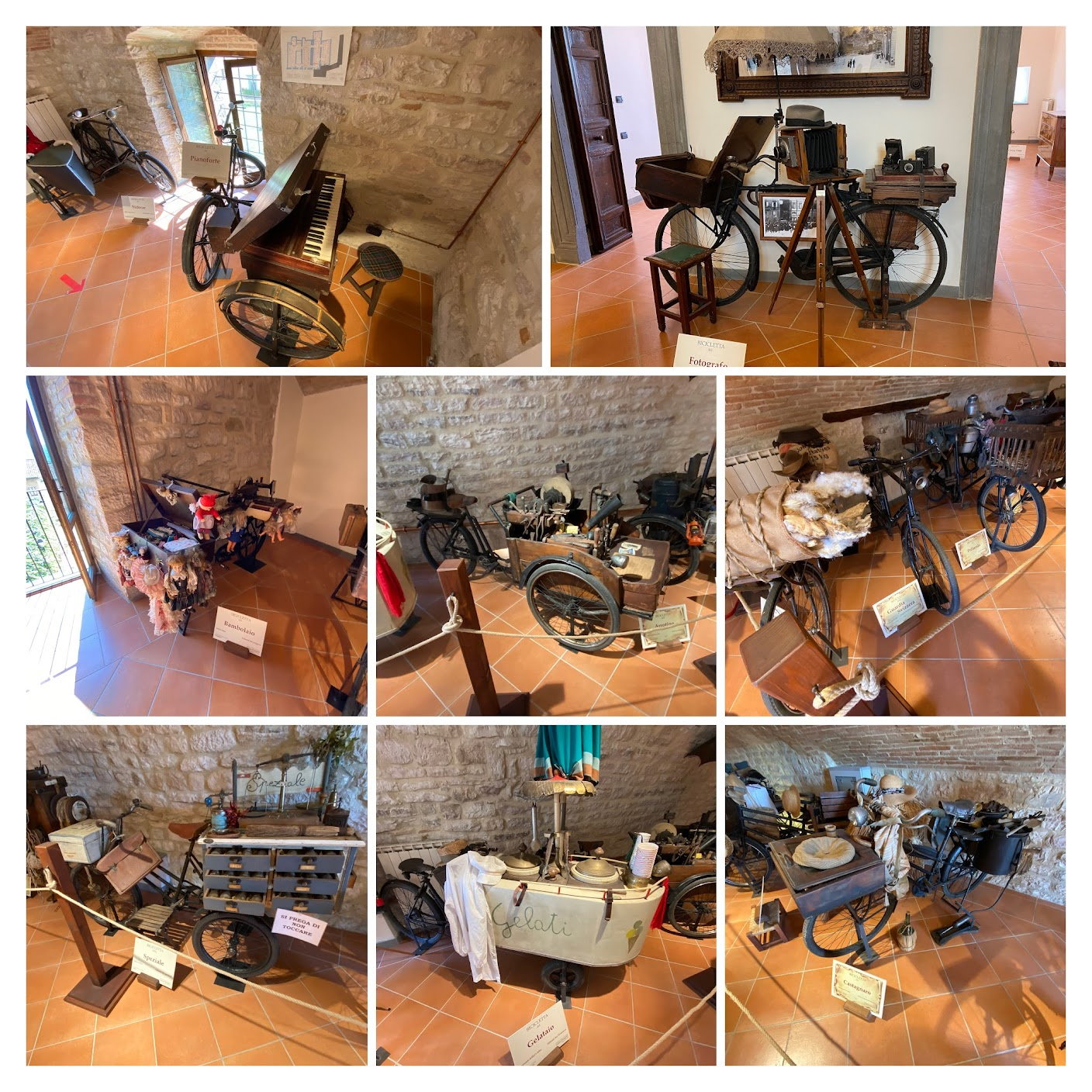
Back on level land, we came across a great firefighter bicycle outside a museum in a great old building. We often skip private museums, but they had us hooked. They have something like 150 bicycles that were essentially early versions of mobile offices or food trucks. Since we have seen few of these anywhere else and there are so many for different professions, we were a bit skeptical of their authenticity. But someone would have to work hard to re-create the variations on the bikes themselves, the aged look and all the tools and accessories. Gelato seller, photographer, glazier, plumber, teacher, doctor, writer, ice shaver distiller, storyteller, and spice seller are among them. Quite memorable experience, such that I am providing the extra photos above.
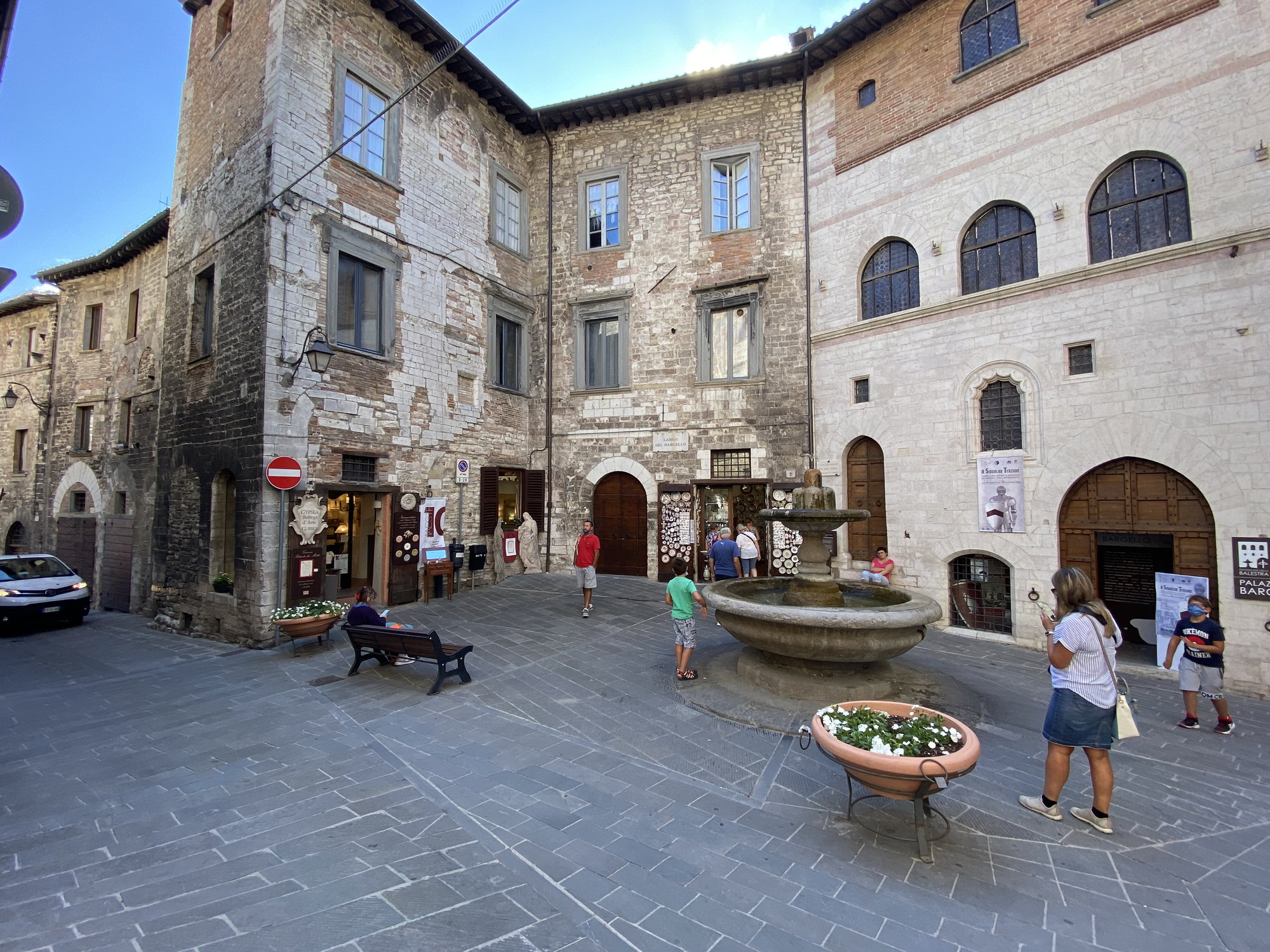
One small square had a fountain and what was the Medieval police station (now housing an unrelated small museum). The fountain, Fontana del Bargello (name of square and palace where police magistrate lived hundreds of years ago) has some popularity in Italy as an oddity. Legend has it that a local must “baptize" you in the waters of the fountain, and the baptized person must run three times around the fountain. Once completed, you are certified as a “madman of Gubbio”. You can also purchase a certificate of your lunacy at a nearby store. (Studies suggest that some water in the area has a lot of iridium, a toxic chemical that might explain where some of this stuff comes from). We decided to keep our sanity.
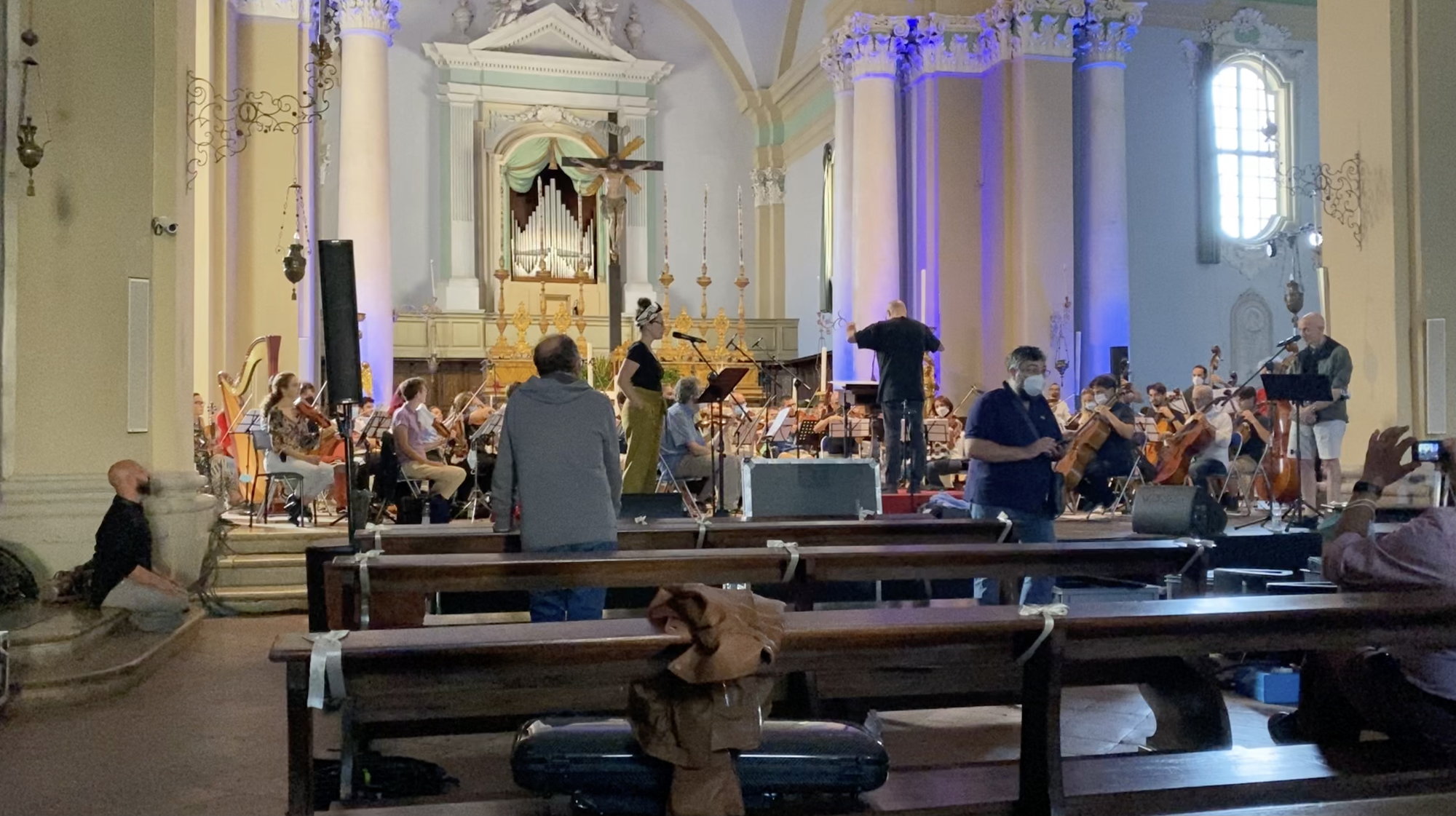
A short distance from the fountain, we heard what sounded like a classical music concert. We followed the sounds to the Church of San Domenico where a very large orchestra filled the altar area. A woman, with a beautiful voice, was rehearsing solo with the many dozen musicians behind her. There was a short break in this rehearsal when a man, treated like a celebrity, showed up to applause. He soon joined the woman in a beautiful duet that gave us chills. Think almost Andrea Bocelli quality. Later in the week, we saw an Italian TV station interview the man about his performance in Gubbio, but we could never figure out anything about the show or who these people were. Really good.
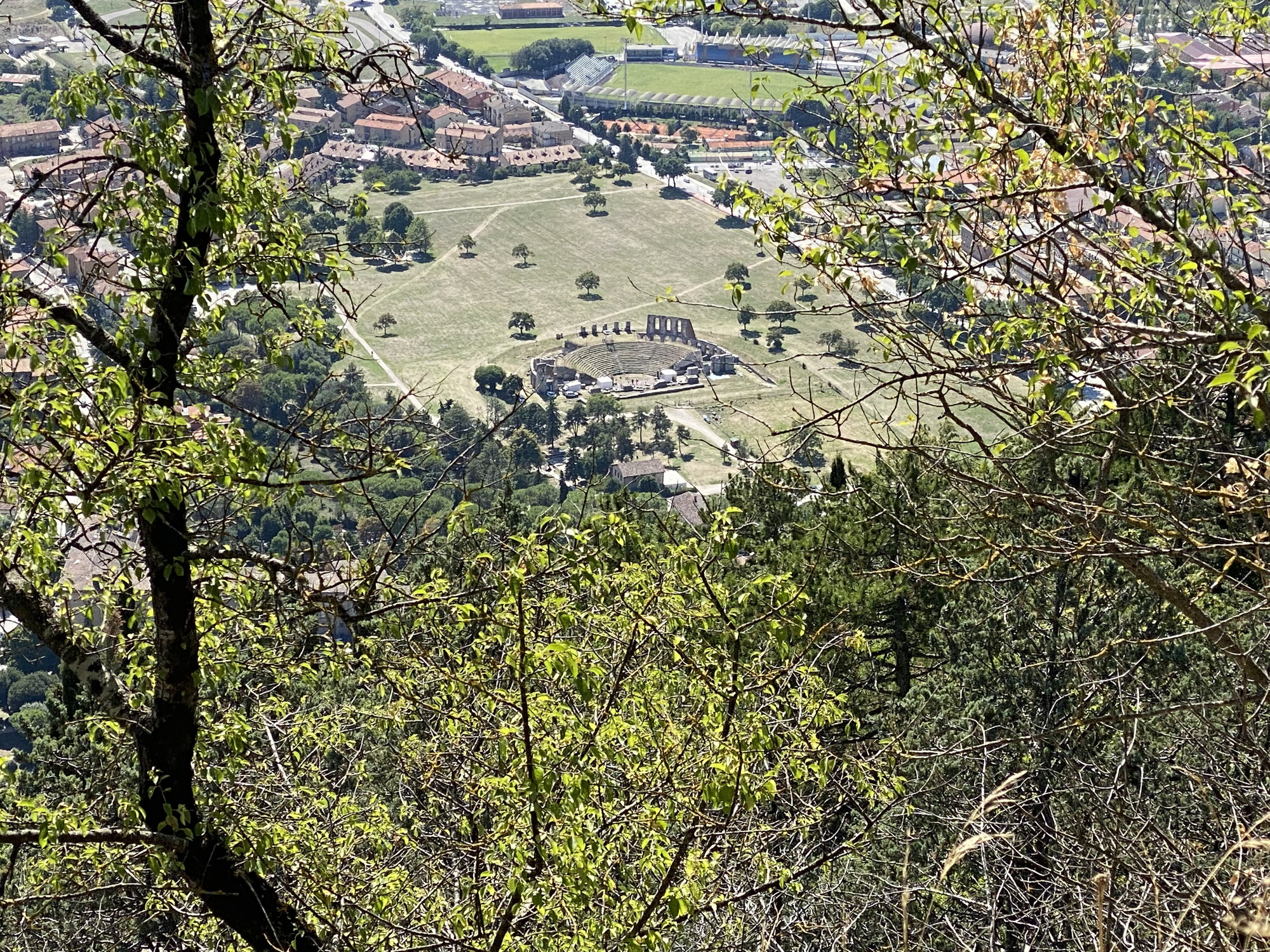
We had read that Gubbio had a small version of the Roman Coliseum, built shortly after Christ. We had no idea where it was until we spotted it from atop Mont Ingino.
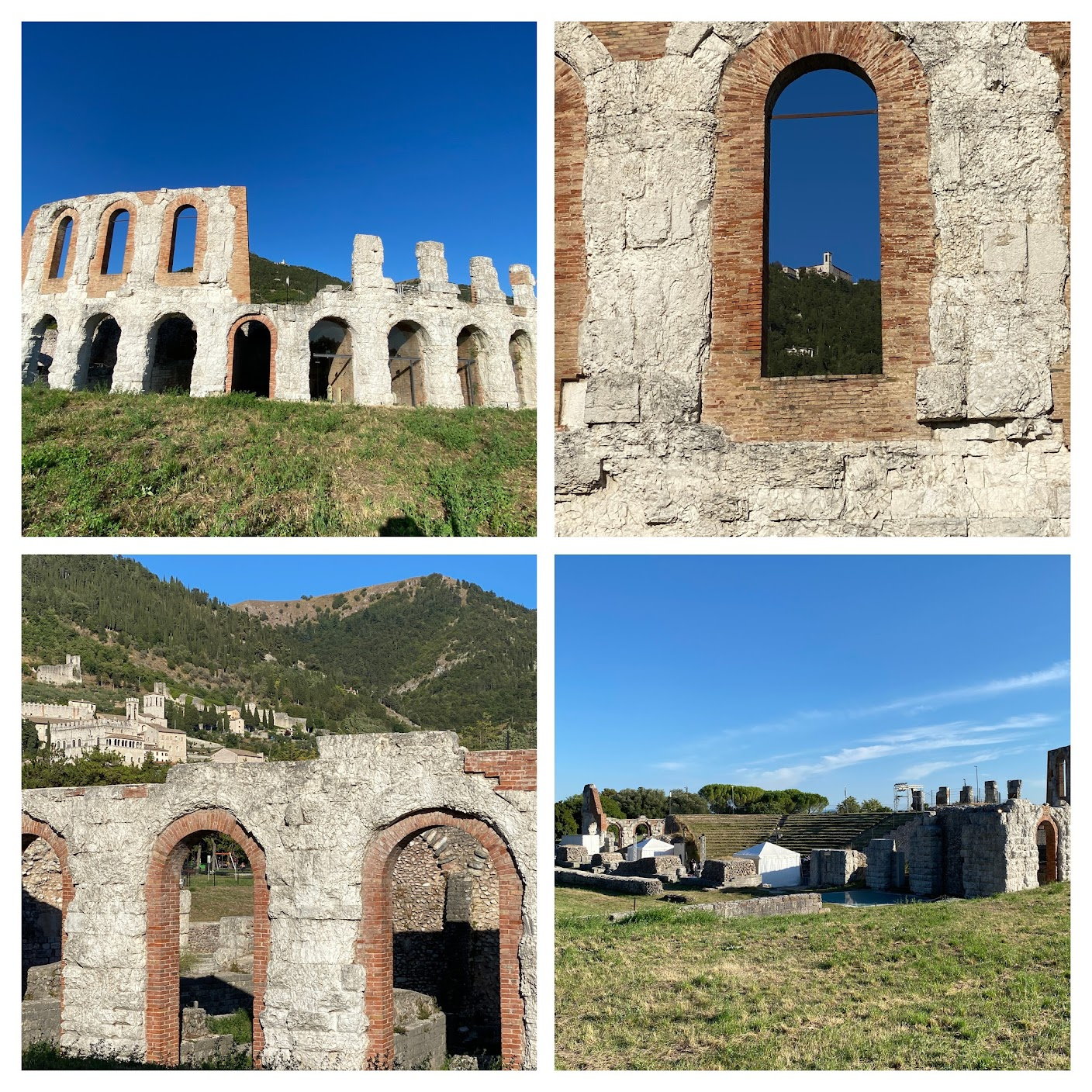
The remains of the Coliseum today are an integral part of the local social scene with all types of musical performances. In fact, when we walked around the place, they were setting up for a concert.
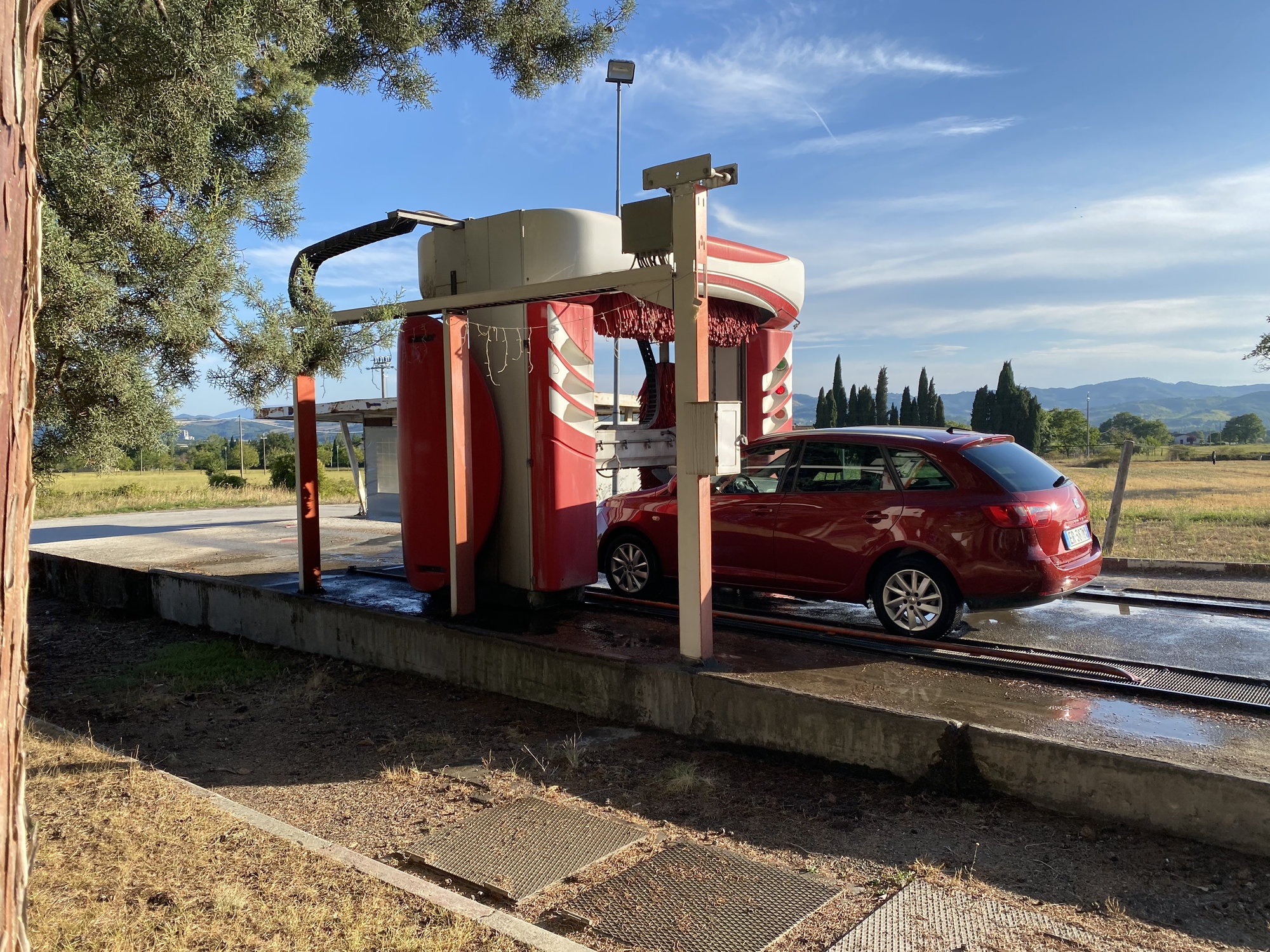
As we drove out of town, we had to stop and take a photo of the tiniest automated carwash we have ever seen.
And dinner back at home in Spello was all local Umbrian stuff from the salad, to the fetteccuni with pesto to the zucchini with fresh mozzarella. And, we kicked back and watched one of our two new favorite prime-time Italian TV shows: "Guess My Age" or one (can’t recall the name) that requires you to fill in the blanks to answer a question with only a few letters showing. Even this brilliant guy, who won almost every day while we were there, didn't answer all the tough bonus questions at the end of each show. His thanks for beating so many people, but not doing 100%, at the end of each show, the floor opens up under him and he really drops, just like they do to each of the day’s eight losers.
#54
Join Date: Jun 2008
Posts: 29,619
Likes: 0
Received 0 Likes
on
0 Posts
We took a bus from Perugia to Gubbio and loved it, whitehall. The bus drop off led us to an elevator to the civic museum square. It was getting close to lunch time closing so we missed it. It was great to see your photos of the inside. I also bought a postcard with the lit tree. It took about an hour to get there.
Last edited by TDudette; Oct 22nd, 2021 at 06:01 AM.
#56
Original Poster
Join Date: Sep 2007
Posts: 1,758
Likes: 0
Received 0 Likes
on
0 Posts
#59
Original Poster
Join Date: Sep 2007
Posts: 1,758
Likes: 0
Received 0 Likes
on
0 Posts
maitaitom Your reference to "bucket of bolts" (for the bird cage cable car) caught my attention, so I looked up your great blog on your trip to Gubbio. I hope you don't mind my quoting your observation so that others will get the reference. "We had dubbed it the "Bucket of Bolts" from the report that said: 'It holds two people, and gives one ample time to admire the view and to study your cage's welding and bolts, which are all that lie between you and oblivion." Nice observation.



